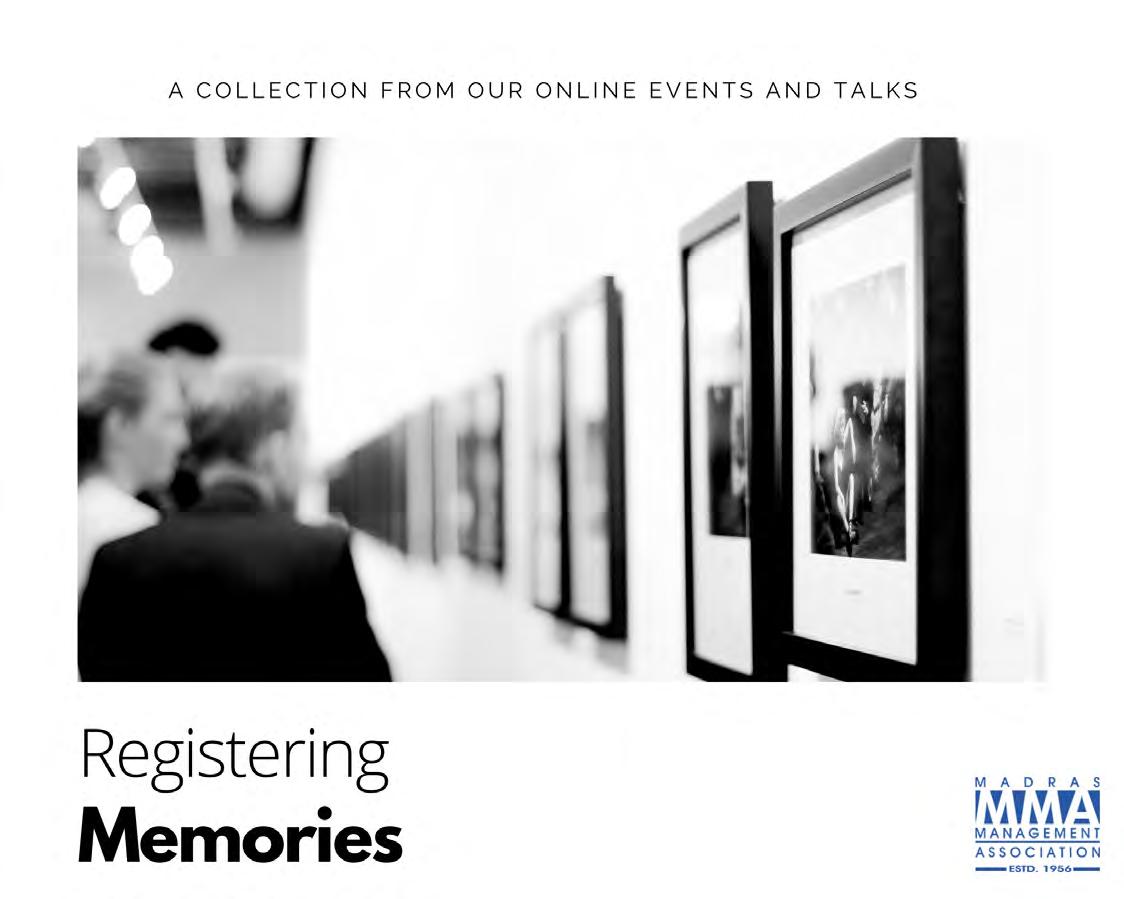


Gp Capt Dr R Venkataraman ﴾Retd﴿



Sundar R



Vakeeswari M
DESIGN
D Rajaram, Tayub Refai





Gp Capt Dr R Venkataraman ﴾Retd﴿



Sundar R



Vakeeswari M
DESIGN
D Rajaram, Tayub Refai

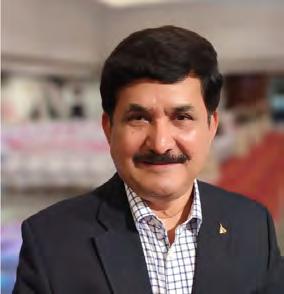
As I pen this editorial, I am filled with immense gratitude and a sense of pride. The Annual General Meeting (AGM) and the awards function held this year were truly exceptional. It would not have been possible without each and every one of you who graced the occasion with your presence and unwavering support. Your participation and valuable contributions throughout the year have been the driving force. Your dedication to our shared objectives has added tremendous value to the growth and achievements of our organization. The highlight of the event was the enlightening address by our esteemed Chief Guest, Mr. Shenu Agarwal. He shared invaluable insights on achieving Managerial Excellence, and his words resonated deeply with all present. His thoughtprovoking and inspiring ideas have left a lasting impression on our minds, urging us to excel in our managerial roles.
Equally captivating was Mr. Shrinivas Dempo's address, where he delved into the theme of changing leadership in changing times. The wisdom he imparted has been greatly appreciated by our esteemed members, leaving us all with a fresh perspective on effective leadership amidst dynamic environments.
Witnessing the progress and growth of our organization is a testament to the collective efforts of our members and well‐wishers.
In this edition, we take immense pleasure in presenting an article that captures the essence of the Chief Guest's address, accompanied by an embedded video. We believe this content will not only be a valuable resource for you but will also serve as a source of inspiration for your professional journey.
Moreover, we are delighted to share the video presentation showcased during the AGM, spotlighting the activities and achievements of MMA during the year 2022-23. Witnessing the progress and growth of our organization is a testament to the collective efforts of our members and well-wishers. Click to view the video highlights.
It is with sincere gratitude that I extend a big thank you to all of you for your continued support to MMA and its activities. Your unwavering commitment and involvement have paved the way for our achievements, and we look forward to scaling even greater heights with your support in the coming years. As we move forward together, let us strive for excellence and continue to be the driving force behind positive change and growth.
The new managing committee was announced during the MMA AGM held on 7th July 2023, and it’s a privilege to work with a team of highly accomplished leaders. We will take forward our vision, guided and supported by the new Managing Committee headed by President Mr. Mahalingam, Partner/Director of TSM Group of Companies. The Managing Committee, consisting of experienced professionals and new entrants with a vast corporate background, would immensely contribute to taking MMA to greater heights. I will be failing in my duty if I do not place on record the great support extended by Mr. Suresh Raman, Vice
President & Regional Head, TCS Chennai, who was our President during 2022-23. He has been a great source of inspiration and support towards achieving our objective. Personally, it has been a unique privilege to be a part of his team. I thank him for his unstinting support in all our endeavours.
With this change of guard, we embark on a new chapter filled with promise and determination. Together, with the support of our esteemed members and well-wishers, we are committed to achieving our objectives and surpassing all expectations.
The opportunities presented by Generative AI outweigh the challenges for India. It can be profitably deployed in numerous ways, and we have a great opportunity to lead its development for responsible value generation. While fears of artificial intelligence (AI) eliminating jobs are pervasive, we have reasons to be particularly optimistic. Indian engineers working in the Information Technology sector may be affected by AI deployment from multinationals, potentially reducing the volume of work. However, to brighten our prospects, it needs to be embraced responsibly. Generative AI has a variety of applications, such as boosting sales or enhancing customer engagements, which, if utilized effectively, can open up exciting new growth avenues for India.
India is a global leader in technology services and entrepreneurship. Embracing Gen AI adaptation is often a pathway to strengthen its position and create new opportunities.
In this context, MMA organized a conclave on the theme "Generative AI: The Future Is Here." Several interesting sessions were held, with thought-provoking views shared by the speakers on various opportunities
and issues connected with the adoption of Generative AI. I am delighted to present in this issue an interesting article on "Understanding the Generative AI Landscape," held during the conclave, for your reading. You can also watch the video recording of the conclave. Click to view...
The countdown for Chandrayaan-3 to make a soft landing on the moon has begun, and the lunar touchdown is expected on 23 or 24 Aug 2023, when a lander is scheduled to descend and roll out a rover. If successful, India will become only the fourth country to reach the moon and the first to physically explore an inhospitable part of it. The pioneering spirit displayed by our space scientists is truly fascinating. We wish them success and fervently hope that we will soon expand the frontiers of what humankind knows about this mysterious object in the sky that has fascinated us throughout the ages.
The Government of India is making systematic efforts to internationalize the Indian Rupee with the hope that it will become a hard currency within the next decade. The objective is for the Indian Rupee to be included in the IMF's SDR (Special Drawing Rights) basket and be recognized by other countries as part of their foreign exchange reserves. This, in turn, would lower India's financial costs.
The way forward is to encourage Indian residents and foreign parties involved in international trade transactions to use the Indian currency for settling payments. The more such transactions are conducted in Rupees, the greater the international acceptance of the Indian currency for trade settlements. However, it is important to recognize that achieving widespread
The way forward is to encourage Indian residents and foreign parties involved in international trade transactions to use the Indian currency for settling payments. The more such transactions are conducted in Rupees, the greater the international acceptance of the Indian currency for trade settlements.
appeal for the Indian currency abroad will depend on its usability and acceptance in various global transactions. We have a long way to go, but this strategic endeavour holds promising potential for India's economic standing on the global stage.
As we progress towards this ambitious goal, it is essential to maintain a steady and focused approach, fostering confidence in the stability and strength of the Indian Rupee. By gaining trust and recognition internationally, the Rupee can solidify its position as a formidable global currency, enhancing India's economic influence and standing in the world.
The recent Wimbledon match between Novak Djokovic and Carlos Alcaraz for the men's championship was a riveting display of see-saw fortunes. The drama reached its peak when Djokovic's racquet smashed against a net-post in the final set, leading to a memorable victory for the almost 16-yearold Alcaraz, who showcased immense talent and skill. Despite the intense competition, the former champion
Djokovic exemplified grace and humour in his postmatch presentation, setting an inspiring example of sportsmanship.
In contrast, the world of cricket has witnessed unedifying spectacles of sneaky run-outs, leading to heated brouhahas with nationalistic overtones. Recent incidents, such as those between England and Australia, and the Indian women's cricket match with Bangladesh, highlighted how the principles of fair play and sportsmanship can sometimes be overshadowed by a win-at-all-cost mentality.
Wimbledon continues to stand out for its spirit of true sportsmanship, where competitors value the spirit of the game above all else. As we reflect on these sporting events, it is our hope that leaders in our corporate world and young managers will take inspiration from the high quality of sportsmanship displayed by Novak Djokovic and Carlos Alcaraz. Emulating such values in our professional lives can lead to a more harmonious and respectful work environment, where competition is healthy, and the spirit of fair play prevails.
Let us all strive to embody the principles of sportsmanship in our endeavours, remembering that true greatness lies not only in victory but also in how we conduct ourselves on and off the field of play.
The World Economic Forum (WEF) recently released its Annual Report on the top ten emerging technologies of 2023, aimed at professionals across various sectors discussing industry-shaping applications for society. The report's goal is to assist business leaders and policymakers in harnessing the transformative potential of these emerging technologies and promoting their widespread adoption.
The list of top ten technologies identified by the WEF includes flexible batteries, Generative Artificial Intelligence, Sustainable Aviation Fuel, Designer Phages, Metaverse for mental health, wearable plant sensors, spatial omics, flexible neural electronics, sustainable computing, and AI-facilitated healthcare. Embracing these technologies and leveraging their benefits should be our collective endeavour for the betterment of everyone.
In line with our commitment to knowledge sharing and innovation, MMA will organize informative sessions on each of these technologies throughout the year. These sessions will offer valuable insights and practical applications, ensuring that our members and stakeholders stay at the forefront of technological advancements.
In this issue, I am delighted to present to you engaging articles on How to Make India Water Resilient, Women and Sustainability, Real Estate - AGILE, and much more. We encourage you to explore these pieces, watch the accompanying videos, and be inspired by the endless possibilities that lie ahead.
As we move forward, let us embrace these emerging technologies with enthusiasm and vision, driving positive change and creating a better future for all.
We urge you to constantly send in your feedback —positive ones as well as criticisms, both equally are important inputs in enabling us to get better at what we do.
As always, we would be happy to hear your views, comments and suggestions.
Thank you for your continued support and readership.
With regards,

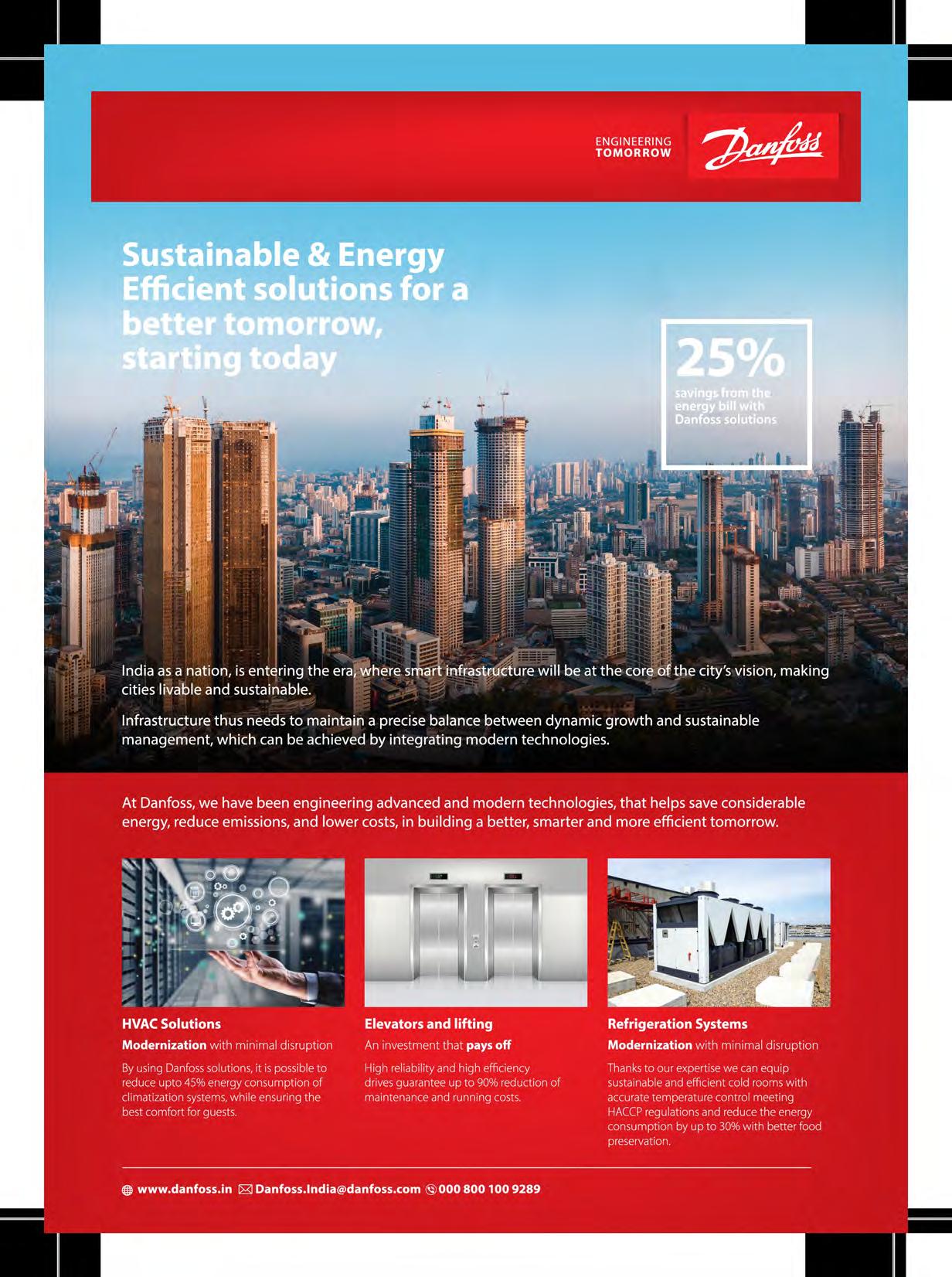
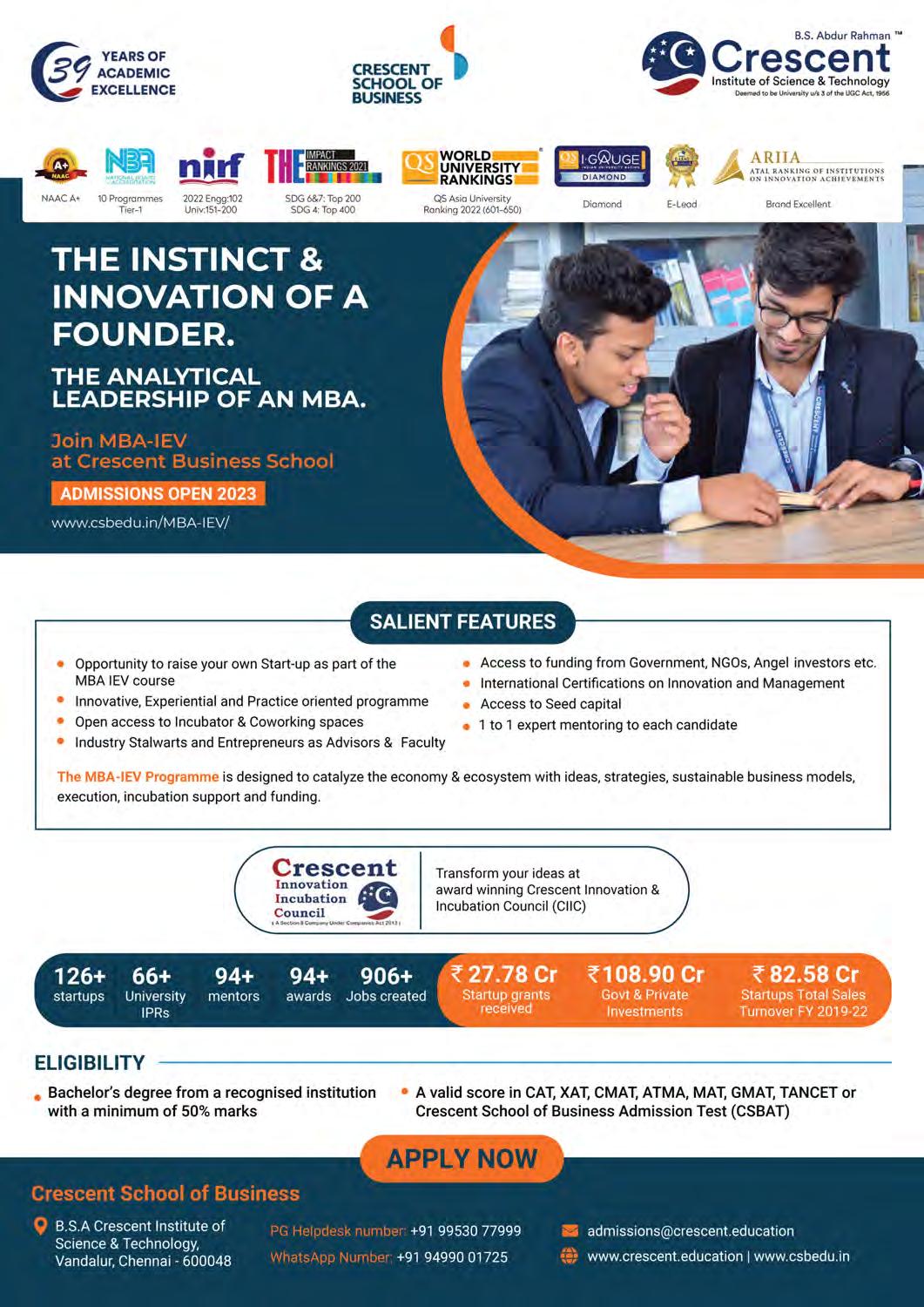
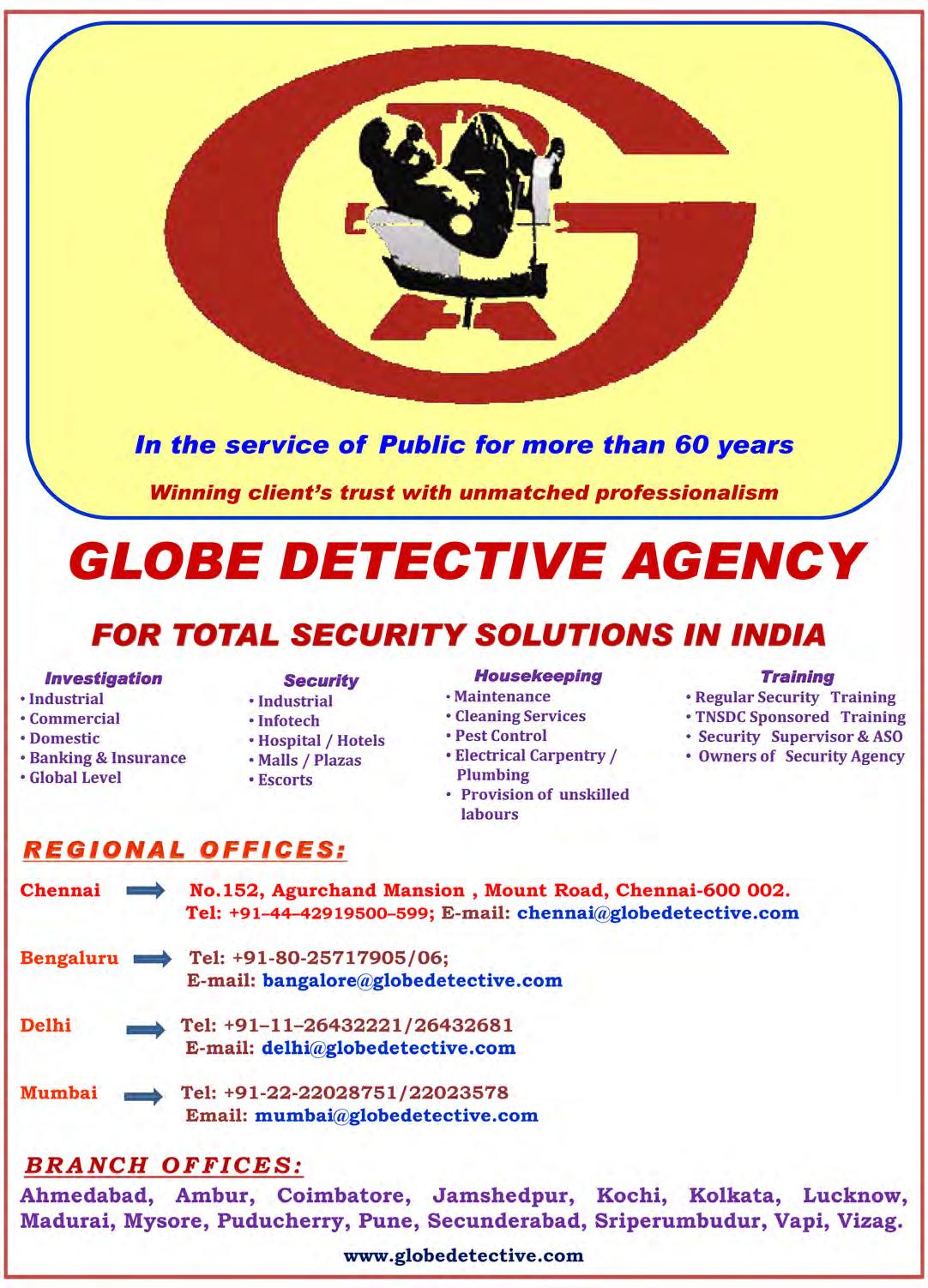
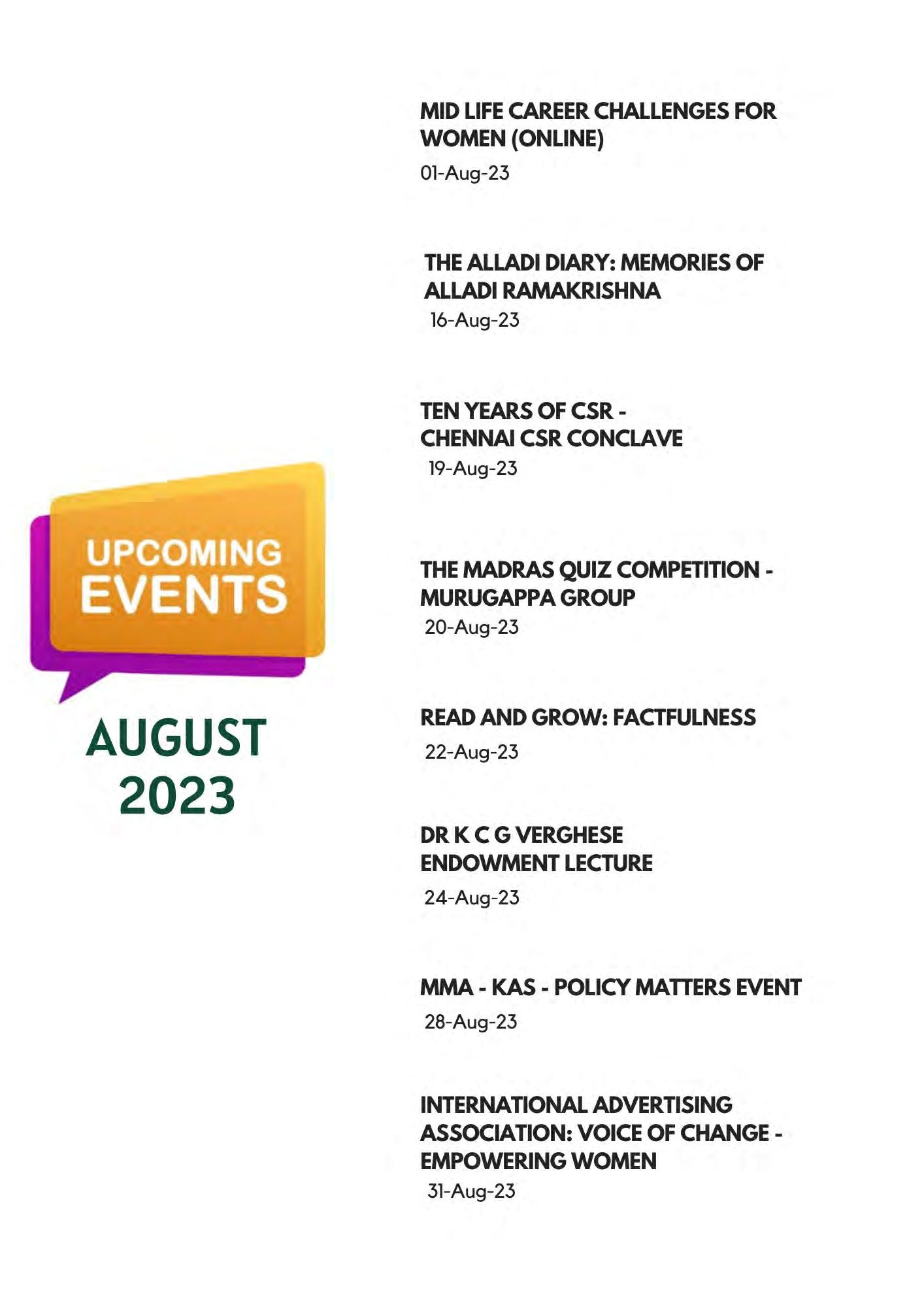
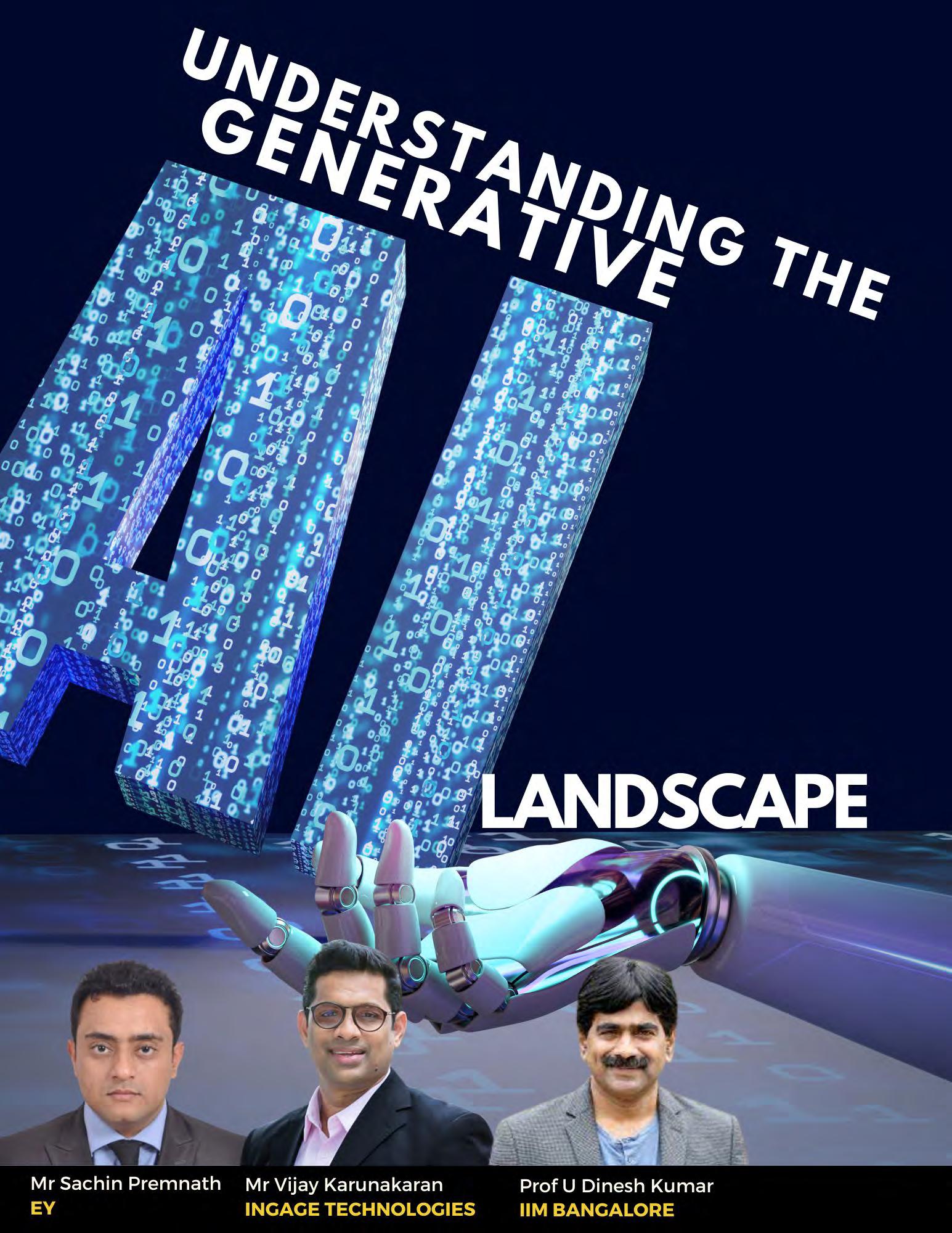 Mr Sachin Premnath Director‐Business Consulting, EY
Mr Sachin Premnath Director‐Business Consulting, EY
ChatGPT has generated a lot of interest both in the investment and technology communities. Business users are now asking us if we can apply any AI component to their work. This is the opposite of a year ago when we used to pursue customers to try Gen AI in their work. ChatGPT is the fastest to reach 1 million customers, and a lot of venture capitalist funding goes into it.
There are social, economic, and legal constraints in using ChatGPT, and laws have been passed in the US and EU regions regarding its use. Stanford has conducted a study on how various models are performing and how reliable they are. There are places where people have applied AI in their day-to-day work, such as preparing a speech, generating templates, wordsmithing, and writing emails to clients, which are perfect ways to use it. You could also use it to improve revenue opportunities and identify new revenue
The making of the ‘thought engine’ and how far have we come, was a session theme at the recently concluded convention on AI. A team of eminent panelists discussed the challenges and opportunities brought in by AI.
streams that did not exist in the past. However, one has to be judicious in using the various components of Gen AI.
Over the last decade, people have been using the words AI and ML interchangeably. AI is a holistic field of study that encompasses machine learning algorithms. The more layers you train AI, the more it becomes deep
There are places where people have applied AI in their day‐to‐day work, such as preparing a speech, generating templates, wordsmithing...
learning. It has evolved from natural language processing and has been trained specifically from a tech standpoint. Today, unless you want to experience it, you don't need to go to Paris and stand near the Eiffel Tower for a picture. You can use Gen AI to create a more realistic image of you by the Eiffel Tower. From a source code generation standpoint, many of my clients are leveraging this, especially for re-platforming from one language to another. It's not limited to text anymore. You can create content, images, music, videos, and pretty much anything; it is possible now.
Any enterprise can be broken down into three layers: analysts, function heads, and CXOs. All three of them can leverage Gen AI, and there are various use cases for it. You can use it for searching knowledge databases. When you are on a call with a customer and need to refer to an SOP document before responding, Gen AI can search those documents and provide a relevant response. The function head can use the search functionality to gain insights from the document. Thus, it can be applied to every role.
Mr Vijay Karunakaran Founder & CEO, Ingage Technologies Pvt LtdEven a year before ChatGPT hit the market, we had been using Gen AI for a lot of content generation. I also advise the Tamil Government for AI projects. We help the forest department monitor and track the movement of elephants so they don't get killed on the railway track.
I am going to discuss the role of semiconductors and Metaverse. Semiconductors drive the Gen AI explosion. On average, close to 10 million people log in and send queries to ChatGPT. They get 8 billion searches every single day. That's going to cost them heavily, and it is not going to be free for too long. They already charge for ChatGPT Plus. Even if you pay $20 a month, you're restricted to a certain number of queries per day or per week. Why is that?
The real cost comes from computing. There are many semiconductors. We moved from the PC world in the 1990s to a smartphone mobile world in 2000. It is
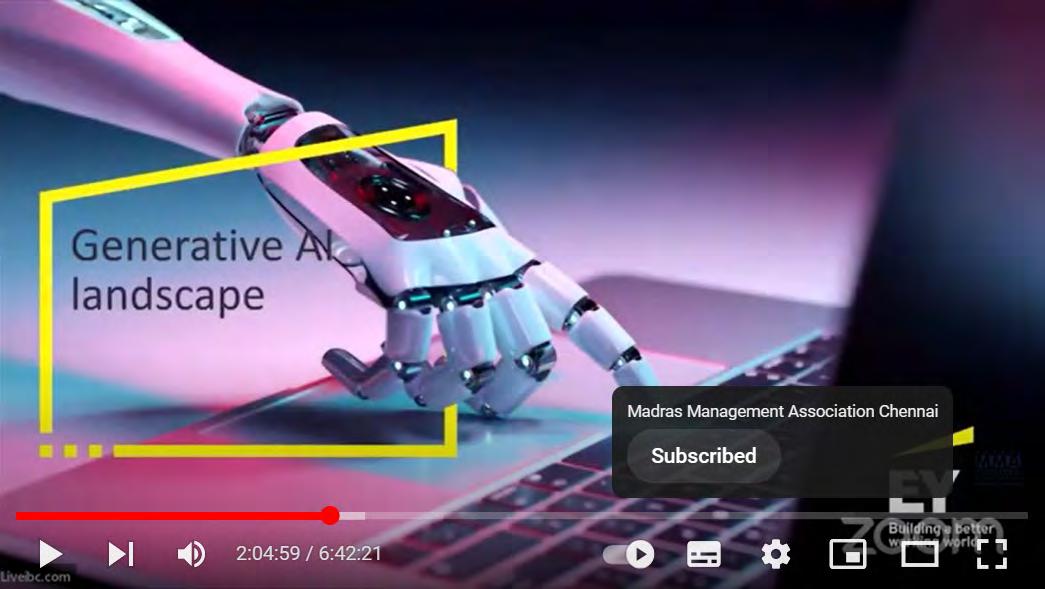
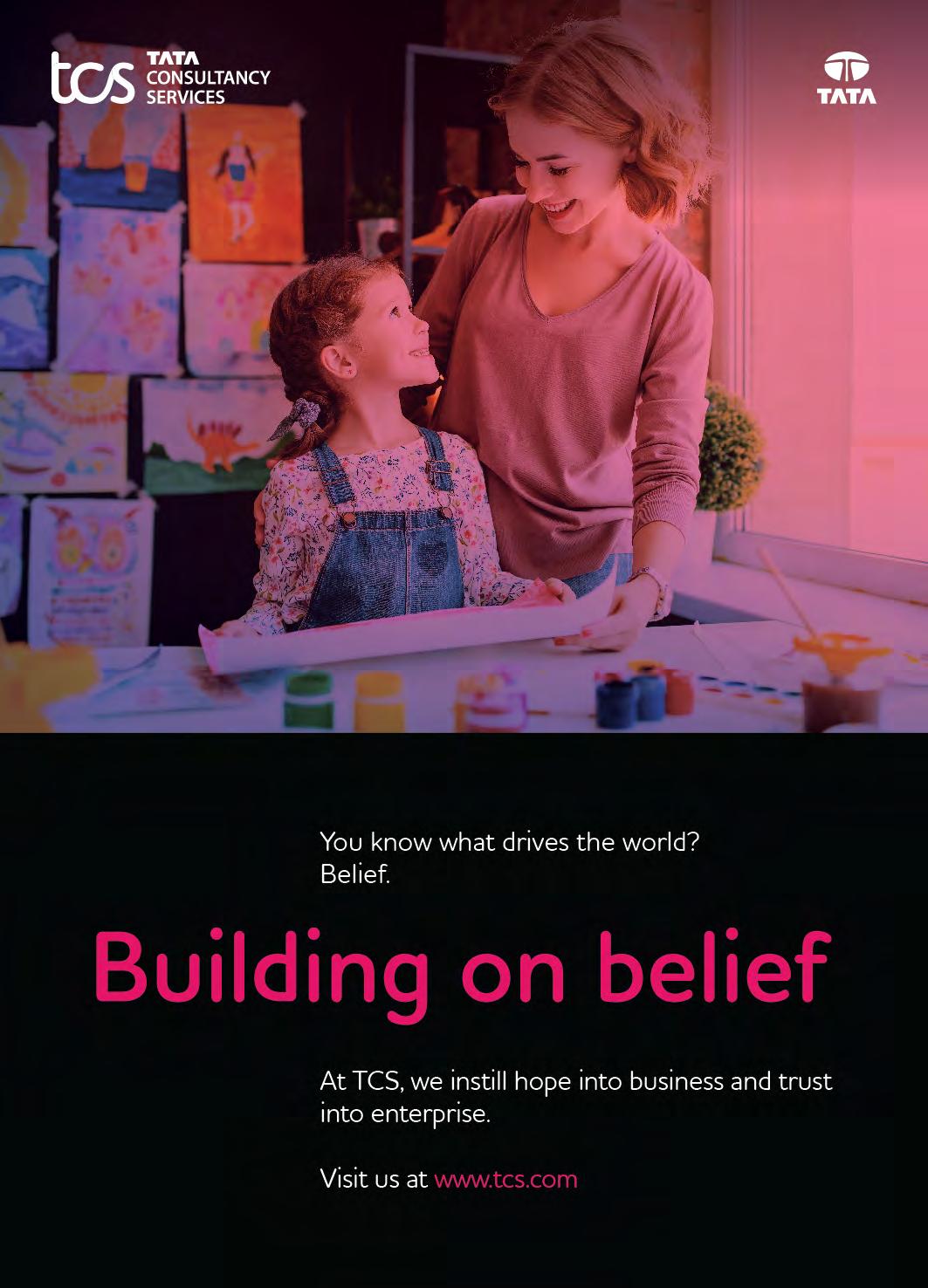
the CPU, the central processing unit, that is delivered by the Intels and AMDs of the world that drove the PC computing. Then came the mobile smartphone computing, also a CPU, but we had a new entrant called ARM processor driven by a bunch of semiconductor companies. Now, we are entering the new role of AI computing, which can also be called immersive computing or spatial computing
Across the PC computing market, the economic share of the technology stack for semiconductor companies was close to 20-30%. That dropped to 10% in the smartphone era because the smartphone market exploded due to applications. It is the software that took a major market share of the entire economic value of mobile computing. Now, for the next five decades, as we are entering generative AI, it is a great opportunity for semiconductors to recapture 40 to 50% share of the entire technology stack. The semiconductor is the most important component of generative AI.
There are four layers in the AI stack:
1)Layer 0 is the hardware and the cloud which will drive the AI explosion, and that is where the semiconductor comes into play.
2)Layer 1 is Model Foundation which comes from the Open AI companies.
3)Layer 2 is Integration, Orchestration, and Deployment Tooling, which includes all the frameworks and is provided by companies like Google and Microsoft.
4)Layer 3 is AI applications like ChatGPT, image creation, and so on.
There are various types of semiconductors. We have terms like FPGA, GPU, and CPU. GPU means a graphical
processing unit, while CPU stands for central processing unit. The GPU was born from the requirements of the gaming industry. It is highly parallel processing. The company that makes that is Nvidia. There are only four companies that are beyond $1 trillion. The first is Apple at $2.6 trillion. India's GDP is only $3 trillion. Then comes Microsoft, Google, and Saudi Aramco. This is followed by Amazon and Nvidia. Its market cap doubled in the last one year because it is the GPU of Nvidia that drives the AI industry. A CPU in a computer costs only $80 or $90, but an Nvidia chip costs $10,000.
On the other hand, while it costs one billion dollars to build a data center using CPUs, it costs just 100 million dollars (just one tenth of a CPU) for a GPU-based parallel processing data center. Hence, there's a huge demand for GPUs of Nvidia. Intel is trying to catch up. In the last five decades, oil and gas was the currency for international diplomacy in geopolitics. For the next five decades, it is going to be semiconductor chips. Why does America defend and spend billions to save Taiwan? Is it because they like Taiwanese people or their noodles? No. It is because they have the world's best top-notch cutting-edge fabrication company called TSMC, which controls 90% of all the advanced chips manufacturing
Facebook changed its name to Meta because they think that the Metaverse is the next computing and it’s going to be the future. Over the years from the 1940s, we have come a long way in computing. We had
There are only four companies that are beyond $1 trillion. The first is Apple at $2.6 trillion. India's GDP is only $3 trillion.
workstations and floppy cards. Then we moved to PCs and laptops, and now we are in the smartphone era. The touch and feel interaction with the device is going to be immersive as we go forward. We're going to use gestures and eye movements to do the computing. That is where we're heading. Then we have the AI edge driven by augmented reality and Blockchain.
We have also moved from Web 1.0 to Web 2.0 and Web 3.0. In Web 1.0, when we enter the URL, we get the data from the server—which is Read Only. That was the start of the internet revolution, and it was there for 10 to 15 years. Then came web 2.0. Currently, most of our applications are on web 2.0. It can read; it can write. When you order food on Swiggy, you give a lot of information about yourself, your location, and your credit card; it means that you are writing data from the device to the server. That's what helped the entire mobility ecosystem.
But there are two drawbacks to web 2.0. Number one, it is centralized. That means anything you send hits the server and goes back. At the server, there are people like Facebook, who give the products WhatsApp and Instagram for free. They give it free because for them, you are the product. They store the data to analyze your behavior and offer products that you may not need. The second drawback is it is twodimensional.
Web 3.0 is meant to solve that by doing decentralization using blockchain technology. That's number one. The second is delivering immersive 3D content. Engagement delivered by augmented reality and virtual reality put together is called the Metaverse. That's where the world is moving, whether we like it or not. Right now, the devices are on our head. At some
point, it can become smaller and smaller. It's more an enterprise game show now. But soon when Apple launches its app—Vision Pro, the market price may come down. 80% of the content of the Metaverse could be generated using generative AI.
What are the problems with Large Language Models (LLMs)? How much can we trust large language models? LLMs use Internet data. The question is, can you trust the data on the internet, and is there bias in the data?
Let me give you an example.
In an internet poll conducted in the year 2000, Jamie Pollock was voted the most influential man of the past 2000 years. Not many can recognize him. In that poll, Jesus Christ came second, followed by Karl Marx. You may wonder how he got the largest number of votes.
In 1999-2000, he was playing for ManCity, which had just won the Champions League and Premier League. It was a division one team. It was the last match of that season, and they were playing against another team called Queens Park Rangers (QPR). Both these teams were in a critical situation because if they lost the match, they would be relegated. In that match, Jamie Pollock scored a self-goal, and Man City was relegated to division two while QPR stayed in division one. This internet poll was done immediately after that match. All the fans of QPR voted for Jamie Pollock as the most influential man of the past 2000 years. That's how he got a large number of votes.
The point I'm trying to make is that you must know where you are getting your data from for your large language models. What is the source of the data? I asked this question, “Who are the most influential men of the past 3000 years?” ChatGPT said, “Confucius, Julius Caesar, Leonardo da Vinci, Karl Marx…” and Jesus Christ was missing from the list because I said the last 3000 years. When I asked, “Did Jesus agree with Buddha's idea?” it gave me some answer. It said, “Yes, there are similarities, but they never met at all.”
On YouTube, there is a BBC documentary titled, “Is Jesus possibly a Buddhist monk?” If you include YouTube data, the answer might have been different. The problem when we use large language models is that we have to be careful where the data is coming from. The second is, there could be bias in the data. For example, if you take any other form of medicine other than allopathy, Wikipedia will say they are all pseudoscientific, whether it is homeopathy, naturopathy, or anything else. Wikipedia also says that 80% of the population of India and Nepal actually use something other than allopathy. Basically, it says that one-sixth of the population has used pseudo-scientific methods. Can you trust Wikipedia data which is heavily used in large language models (LLMs)? LLMs have a large number of limitations. They cannot predict.
But having said that, LLMs can contribute in multiple ways—in text generation, code generation,
image generation, speech, video, 3D, and other forms of data. We can create data that would otherwise be difficult. When AI came into discussion about 100 years back, people wanted to create something that would imitate humans, but all that has changed. What we see today is that humans actually imitate Gen AI systems. In the last 10 or 15 days, the entire media world was focusing on Oceangate, the submarine that imploded in the Atlantic. The problem with these innovations is that we have very limited data about the materials that were used and to what extent they can survive the deepsea environment.
People try to see how Gen AI can help in treating neonatal sepsis, in which newborn babies can die because of sepsis. Sepsis is a bacterial infection, and there is a very high chance of death. In India, the mortality rate is 35. We are looking at non-invasive procedures to solve this problem. Can we look at the baby’s parameters and mother’s parameters and predict the chance that the baby may get into sepsis? Asha workers in India carry a lot of data. Can we pull that data together and come up with a model that can help reduce neonatal sepsis deaths?
Thanks to Gen AI, we can create solutions where data-driven decision becomes very easy and accessible to everybody. For example, if somebody asked me a question, “Should I invest in Infosys stock or TCS stock?” At the back end, I can run AI models and generate data, but GenAI can't predict things. So I have to integrate other machine learning algorithms to do enhancers kind of things.
There'll be a lot of jobs that will be created through AI technology. ChatGPT is an information synthesizer. Unless you integrate many other technologies, it is not going to be a thought engine. We are far away from that, but there are efforts to make it a thought engine.
When AI came into discussion about 100 years back, people wanted to create something that would imitate humans, but all that has changed.
India has been trying to get into the chip manufacturing space. When is it expected to see the light of the day? How much investment is required for India to become a leading chip manufacturer?
Vijay: In semiconductor manufacturing, there are three dis nct phases. The first phaseisthedesign,whichisdoneusingPCs andso ware.Oncethedesigniscompleted, it is sent for manufacturing where the fab comes into play. A er the first few prototypesbecomeavailable,theyundergo the post‐silicon valida on process. India already has a large presence in the first phase, i.e., the design phase. All the major playersinthesemiconductorindustry,such as Intel, Qualcomm, and others, have a presence in Bangalore and other parts of India. Semiconductor manufacturing requires close to $10 to $15 billion in investment. The money is not that difficult for a country the size of India. What is crucial is the technology transfer. India has reopenedthePLIwindow,andVedantaand Foxconn came up with a deal for some manufacturing, but it got stalled because they couldn't find a technology partner.
The technology we are considering is very outdated,probably28nanometerthickness, whereas the current chips come in 4
nanometers size. India must get close to AmericaandtrytoinfluenceTSMCtoinvest inIndiaandbringthetechnologytransfer.It is no longer just a money problem. How do we see the manufacturing industry five years down the line, using AI?
Sachin: AIhasalreadybeenimplementedin manufacturing,atleastforthelastfiveorsix years. I have worked extensively with AI in manufacturing,especiallyforpharmaclients, tomanufacturehigh‐qualityso gels.Specific computervisionandAIusecaseshavebeen implemented. We can detect, from a safety standpoint, if people are wearing helmets and other safety gear. AI will make further inroads and grow much more to improve efficiencies and reduce costs.

Prof Dinesh Kumar: There are a large number of applica ons of AI in manufacturing. We have worked on projects in manufacturing systems to predict whether there will be a fire in the next10minutesusingIoTsensors.Wehave also worked with many automobile companies to predict failures, warranty claims, and detect any fraudulent claims.
AI is being used in almost every sector.
Is it possible to translate more than one language at the same time?
Sachin: Yes, the Government of India has a specific ini a ve called Bashini (Basha Interface)usingwhichalotofchatbotsare being developed, and the language accuracy is extremely good.
Prof Dinesh Kumar: In the UN Council, members from more than 150 countries speak different languages. Whenever a speaker speaks in any language, it automa cally gets translated.
Dinesh: Another good applica on is a 3D avatar of a person delivering a speech.
With respect to Web 3.0, the data will be more personalized. What happens to the data science professions, which are more dependent on data?
Vijay: Obviously, upskilling is required. There won't be any job loss. There will be realignmentorreassignmentofvariousjob roles, and people will upskill themselves.
Prof Dinesh Kumar: DataSciencewillnot go away because ChatGPT cannot predict. It's a language model. Data scien sts predict.PeopleuseLLMbecauseit'safun applica ontoday,butsoontheywillrealize thelimita onsandneedtobringinAI/ML and other models to integrate them with large language models to solve problems.
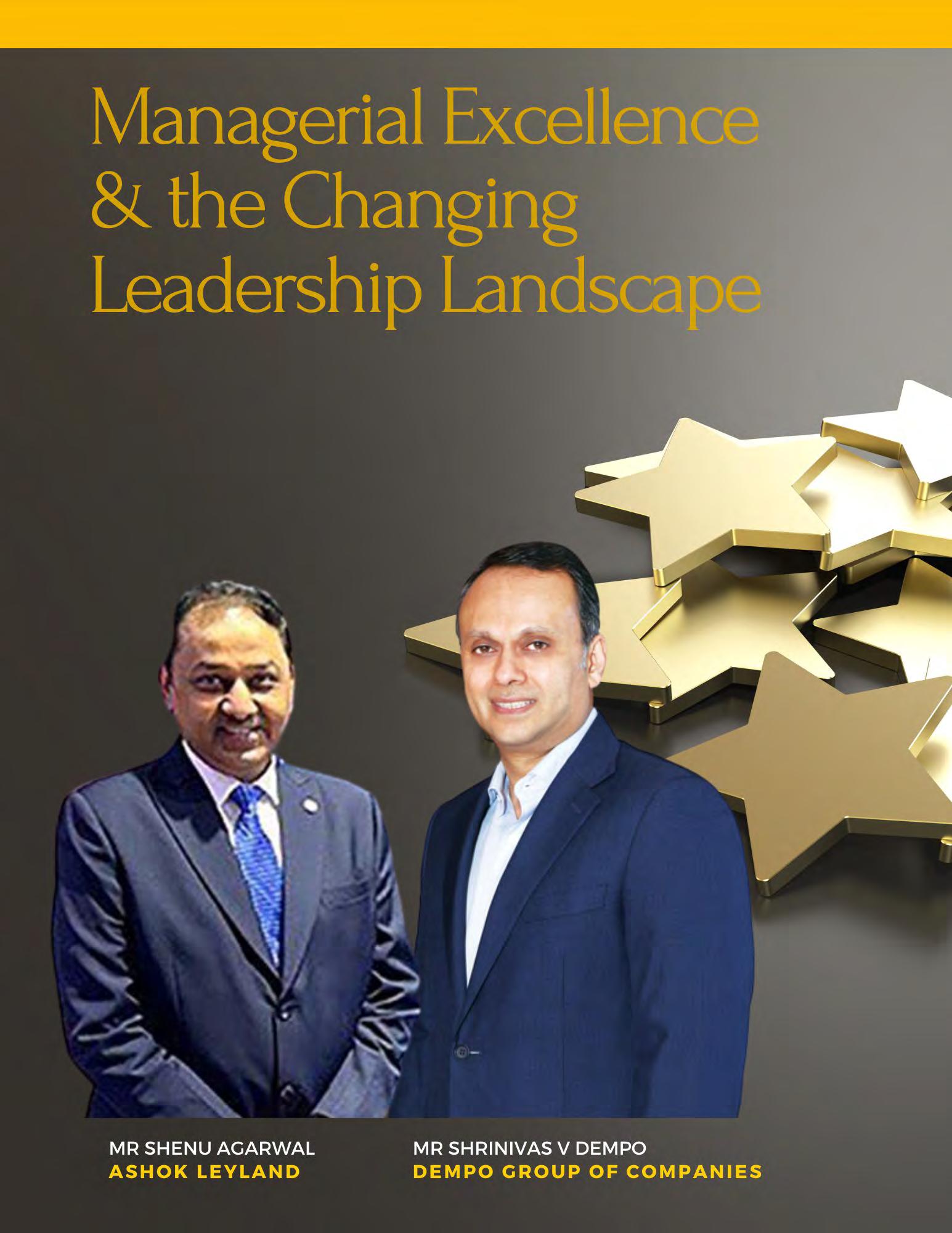
and it is getting repeated, it is not the mistake of a lower level manager but that of a senior level manager. Probably the manager has not taken enough time or effort to clarify the purpose or mission or the goal. The manager or leader must clarify the purpose again and again and only then the desired results will come.
Mr Shenu Agarwal MD & CEO, Ashok Leyland
Five or six points are very important for any manager or a leader: clarity of purpose, clarity of path, clarity of role on one side and then getting ready for the job, managing time, and connecting with the people. In the management world, we play the role of a soldier or that of a general. As a general, we have to see ahead of time, predict situations and tell our troops how to deal with those situations.
Clarity of purpose, mission, goal, task or whatever we want to get done is requirement number one. A lot of times, I see that a manager's vision is something and the action on the ground is entirely different. When that happens, it is very hard to get magical results. If there is something wrong happening in the work environment
The second most important point is the clarity of path. Generally speaking, there are two types of managers in the management world. One is the specialists and the other is generalists. We must be clear if we want to become a specialist or a generalist. The world needs both in probably equal measure, but a lot of people make a mistake in the corporate world. They just can't decide if they want to go deep or wide. Their career path depends on this particular attribute.
I am a generalist and it suits me. If you want to become a specialist, you must work with the best, so you can become the best in a particular field. If you want to become a generalist, it is not so important to work with the best. But it is more important to try different challenges and do different things. I started my career as a graduate engineer trainee. I got into
technical services—a field job, then moved into sales after four or five years and later to international business. Some of these, I did intentionally and some of these just happened to me. But I was very fortunate to work in two very different areas. To become a generalist, you must have a wider perspective about the business. Managers must identify specialists and generalists in their team, depending on their capability and also choose their own paths.
There are only three kinds of things we do as managers or leaders. We do daily work—the routine jobs. Visiting a customer, making a pitch and coming back is a routine job for a salesperson. The other part is improvement and the third is breakthrough. All three are important. Breakthrough is like disrupting something that has been happening the way it has been happening for years and doing it very differently.
I have 30 years of experience in the corporate
world. I see a lot of top managers doing routine jobs not just 10% or 20% but much more than that, engaging themselves in routine jobs and doing firefighting because that is the way they have learned, growing up from the bottom. When you excel at doing routine jobs, you think that is how you should always be. You must have heard of a thing called midlife crisis or mid-career crisis and this is what that crisis is.
In a junior management role, 80% of your time goes in routine jobs. As a middle management person, probably only 50% should go into routine jobs and as a top manager or a leader of an organization, function or department, only 20% of your time should go into routine jobs. This clarity of role of who I am, what and where I am supposed to devote my time and effort is very important. A great area sales manager can sometimes become the poorest or the weakest zonal sales manager. You will see this all the time, because people just don't realize that they have to do different things when they grow.
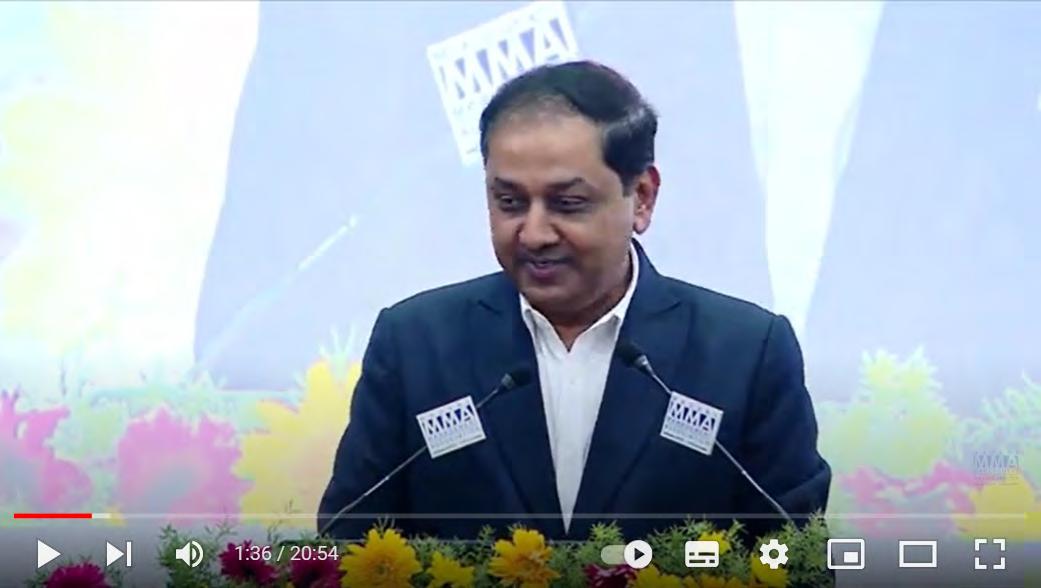
Getting ready for a task requires acquiring the right skill and right competency. Most organizations or most of the HR people focus only on one part of the manager which is the mind and its learning. They don’t focus on the body and the soul. Spiritual gurus will always tell you that you cannot be successful until the mind, body and soul are all trained and developed together over time. I see very little emphasis, at least in the corporate world, on training the body and even lesser emphasis on training the soul.
Work-life balance is a big issue in the corporate world. I have found a very simple method to tackle this. You have both external and internal customers. You also have tools and technology. I have observed a lot of successful people very closely and talked to them a lot. They spend most of their time either with customers and / or technology and spend the least amount of time in administrative jobs.
As a leader, I have to attend quarterly board meetings. It like takes me two days in a quarter. I don't think that adds so much value to my life or career. So the best way to handle that is to schedule them. Normally, what I have learned to do is at the beginning of the year, I ask my office to set up my calendar for the entire year for my administrative tasks. The rest of the time is now available to focus on customer and technology. I have spent a lot of time travelling outside with customers, with other stakeholders and with our engineers in our R&D Center. We have to connect with them at a certain level, in a certain way and align them to one goal and one thinking so that we can work together and achieve something big.
In organizations, there is a lot of emphasis on
I have observed a lot of successful people very closely and talked to them a lot. They spend most of their time either with customers and / or technology and spend the least amount of time in administrative jobs.
intelligence. Intelligence is very important, but in most of the situations, intelligence alone does not work. There is very little emphasis on emotional quotient. We hardly talk about this and we are very shy in talking about these things. I have been involved in some major decision makings for years. At least 80% of the decisions are not made with logic but with emotional intelligence. By building a team together that connects each other, that looks at the problem in the same way, that works together to find a solution and that helps each other find a path is more important than just applying mind to a particular problem.
Managerial excellence is nothing but personal excellence in a lot many ways. Only people who are personally excellent can be managerially excellent. If you have lots of issues personally, it is very difficult to excel in some other environment, because you are you. To be personally excellent is to be internally very secure. If you have a lot of insecurity inside, you are not going to be an excellent human being. You will do a lot of mistakes and your mind will be in chaos all the time. So inside, you have to be much secured.
Of course, security means different things for different people. But there is one common theme that gives security to all of us and which is simplicity. We
must live a simple life, which has less needs. Acquiring wealth and living a simple life are two different things. When your expectations are less and when you know that you can survive even with less means, you will be very secure inside. It's not about how much wealth you have or do not have but it is about simplicity. Even very rich people who have accomplished a lot are not secure inside.
that we all have an opportunity to prove ourselves and to contribute to the country's GDP.
But you must also realize that increasingly, the world is getting into VUCA. We have volatility, uncertainty, complexity and ambiguity. That makes the life of a leader, all the more challenging. But there are solutions to all these and the solution is to change your mindset, while keeping all the basics like clarity of purpose, clarity of role, human interaction and vision building intact. These will never change at any point of time.
Mr Shrinivas V Dempo President‐AIMA & Chairman, Dempo Group of Companies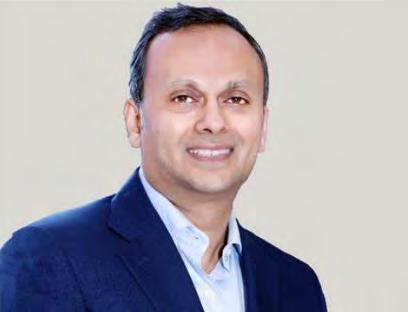
Unlike Mr. Shenu Agarwal, I'm not a professional, though I've tried to get as much education as possible. I am a family person, from the third generation of the family who runs businesses and manages the challenges and also the opportunities that are phenomenal in our country.
In one way, we are connected to the whole world. In the other way, India is an outlier in many senses. You must have seen the body language in the US Congress House when our Honourable Prime Minister spoke there. It's not that they just want to make friendship with us for no reason. They know that India is a powerhouse and will give their businesses an opportunity to expand their wealth and market cap. India is no longer ignored. That's a great news for us
But a leader today has to react differently in different situations. It’s no longer ‘His Lordship’ type of approach in the company. You have to believe in shared leadership and must take your people with you. Today, the lines of hierarchy are slowly disappearing. Whether it's work timings or hybrid models, Covid has taught us a lot of things. When complexity as well as opportunities are increasing, how should a leader behave and react?
You must never fail to recognize your vision. I'll give you an example of what happened to us. Our core business about 10-15 years back was iron ore mining. We were one of the oldest families in Goa, which did iron ore mining. It started from my grandfather's times. We had long term contracts with Japanese steel mills such as Nippon Steel, JFE and all the top leaders of the world. We did this business very sustainably and very respectfully for a very long time.
Suddenly, China changed the rules of the game. What was $30 became $130. What it also meant was it challenged our values and morals, as there were
competitors coming in overnight. They were bypassing all the rules and regulations. They said that if your cost of ore is $20 and you can sell it for $130, then go for it. They abolished all the long term contracts, went to China and sold in the spot market. I was increasingly challenged by this. I had a dilemma, whether to rake in the money the way that all others were doing or if I should be different from them and others.
I said, “No. I will stick to my long term contracts and my core business. Even if I make only $5 a ton instead of $105 a ton, I would stick to my core business.” It became difficult for me to continue when the majority part of the world was looking the other way. Generating wealth is extremely important but it is not the only purpose in life. You run your businesses for a purpose other than money. Money is a side effect. I sold my mining business, though it was my identity in a lot of ways. Imagine Tata Group selling Tata Steel tomorrow.
Our family was known for two things—mining and
football. Football still continues, but mining has disappeared. Why did I do it? Because it challenged my morals and the vision that the founders had set up. I did sell the business at the most profitable time. In three years’ time, mining closed down in Goa due to several illegalities that were happening.
Not that I was a visionary. Not that I foresaw what was coming. But I stuck to my core values and beliefs. The chance of making much more money could be seen in front of my eyes. But I thought it was not my main purpose. My main purpose was to deal with my customers and they weren't happy in the environment that was happening. That's why I sold the mining business. In three years, the government took a firm stand and closed mining. Till today, even after 11 years, the mining has not started. Now, they are taking initiatives. They are running an auction and a transparent bid process. This is my lesson number one: You may be challenged by the VUCA world but please don't forget your beliefs and values. Build and sustain those beliefs and values.

The second is changing Indian entrepreneur mindset. One needs to look at a bigger mindset. Many of us run family businesses and it's not easy to run them. When I took over the business, it was largely a family operated and a family controlled business. We operated in six sectors. Our ancestors had their own way of dealing and their times were different. With technology, geopolitics and all of that coming together on you, you need to build professionalism within your organization, take that risk, and go ahead.
The biggest challenge was, how do we pay a salary bigger than ourselves? We all have egos as owners. As the chairman of the company, if I'm getting an X amount, how can my CEO get an X plus one or X plus two? I came out of that mindset, took the courage which never prevailed in our culture, to appoint professionals in all the six segments that we were operating. Today, I can say in a very humble way that each of the segments has grown at least 3X. That's the kind of risk that one takes without disturbing the vision. You must believe in the empowerment of people.
What Covid helped me to do is empower even my
middle managers. All our factories were closed then and it taught me two things. One is, how to embrace technology, which was not prevalent in an organization like mine. We also had a mix of youngsters and old people and how do we mingle? That's another challenge. How do we combine a smartphone app based population with somebody who is not exposed to this in the past?
We embraced technology and digital mode very fast. We empowered middle level managers, because the situation was such that we had to take very quick actions. It exposed me to a lot of junior and middle level managers, whom I would have never seen in my life. If I was in person in the office, I would meet only with my senior team due to lack of time.
It taught me another lesson—to take risk and be much more open to all the employees in the organization rather than with your three or four key people. Send messages across the board. Have a shared leadership and empower people. With your own experience of running the business for so many years, you must know with whom you should take the risk. To start with, you must empower people one level below you and then start looking for people and empower them. Start communicating to them. The younger generation today is not there only for money. Of course, money plays a very key role but they want a purpose for your business. If they believe in the purpose or the vision of the founder or the chairman, they will join. Otherwise, they will not join.
The third challenge that we face today is, how do we take care of our employees? It's no longer a cost. It's a dividend that you're paying yourself. Earlier, we used to take labour as a cost. Today, you can't think in those
With your own experience of running the business for so many years, you must know with whom you should take the risk. To start with, you must empower people one level below you and then start looking for people and empower them.
terms. Covid has put all of us in one plank. My staff and I could have got Covid and gone to the same ICU.
When we had to cut salaries of employees, we made sure that at the middle level and junior level, there was no cut. It was only at the highest level. It was not even a cut. It was a deferment. You need to take that risk, communicate with people, build the vision that you have created along with people and take them forward. The real challenge is to get all of them aligned to the organization and the only way is to be true to yourself and to be very open about it. Believe that they are part of your organization.
In my grandfather’s days, they used to create a rift between two senior employees, so that they gained. Now, the management methods have changed. Everybody sits in one table and discusses. We have open offices and the cabins are done away with. They only have a sitting area and conference rooms. Change your leadership philosophy to embrace people.
The fourth thing is, you cannot ignore sustainability issues and technology. Many of us think that we are small, we are not in that game and nothing will happen to us. But with the way that things are happening in technology, climate change and sustainability, it's so fearsome, that if you don't act with speed, you will be left behind in the race. We have to be extremely vigilant. We have to start working on a plan. Whatever size you are, you have to go to your drawing board and say, “This is my technology. This is my production. How do I make a difference to the environment and the global climate crisis?”
You have to start with yourself and your employees. Question your organization people as to what you are doing jointly. Initially, we did not take this very
seriously and it only became mottos and slogans at board meetings and press conferences. We got pressure from the reverse side. Some of our customers are based internationally. They sent us an ESG grade chart and asked us where we are graded there. They gave us a timeline and said that if in the next three years, we didn't come to their score, they would be constrained to discontinue their purchase. This is the kind of pressure that is coming
As a nation, we have committed to net zero emission by 2070. Many of the countries have committed to 2050. We are still 20 years behind. We must embrace renewable sources of energy and change our transportation methods.
One of my companies is listed. I wanted to make a letter to the shareholders because the annual report was supposed to be published. Generally, I talk to my research team, which does research on the industry and write. When I asked them about writing the letter to the shareholders, they wanted three days’ time. I decided to try myself with ChatGPT. It took me just three and a half minutes to get the letter from ChatGPT, which was, in fact, better in language. There's a deeper message in this, that you can't ignore technology —whether it's artificial intelligence, augmented reality or virtual reality. We have to embrace it.
Embracing means that you have to expose your employees of the company, make them more aware of these things, train and reskill them. If you don't empower them and reskill them, not only will they lose their jobs, but also, we will lose our businesses. Do not think that you are in a sector which doesn't get embraced by technology. Every single business today is going to be embraced by technology. Covid has changed
so much for us. People want to work from home or in hybrid and they are not willing to come to offices full time. We have to change our mindset, look at it in a different way, so that the world moves on and your businesses move on.
Today, because of geopolitics, there's a lot of distrust. It is commendable that some of our Indian Universities have come in the Top 500 global rankings. But there are three or four Chinese Universities that come in the top 50. We have a lot of catching up to do. India is capable and it has the potential. But we need to understand that we must think big, change our mindsets, empower people and seriously focus on ease of doing business. It is not only for the government to look at it also for the private entities to look at the ease
of doing business.
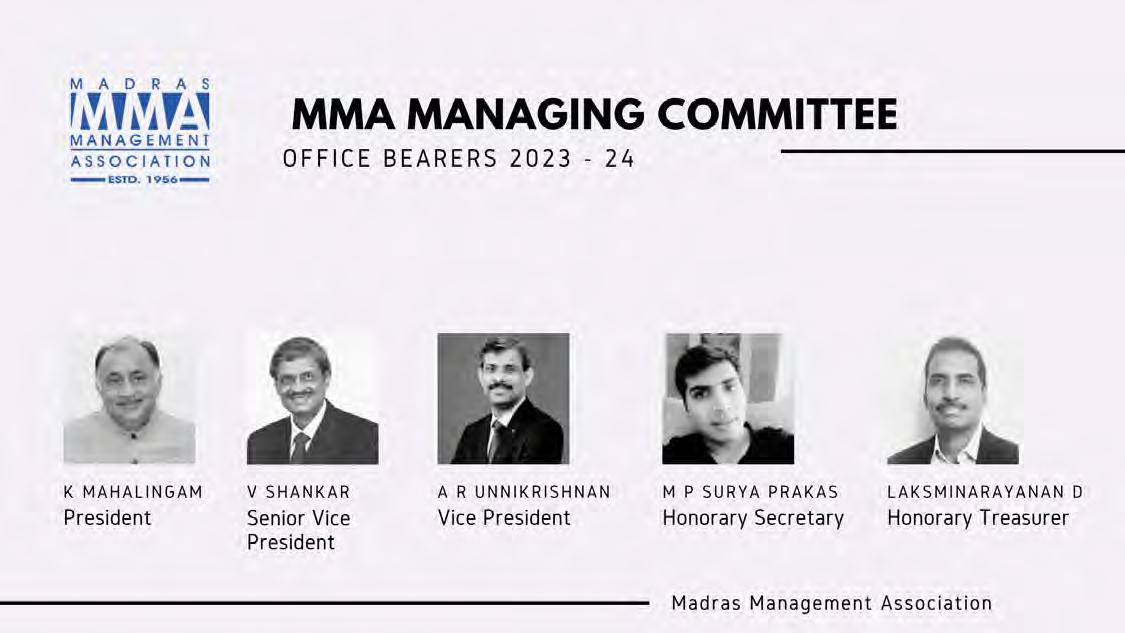
I would like to end with some excerpts from what Mr. Deepak Parekh has written in a recent article in Economic Times: “There is no substitute for time tested values of honesty, integrity and accountability. It is always there. There is no switch on and switch off.
As a leader, you must have clarity, humility and courage. Always ensure that humility sticks with you like glue. There is no softer pillow to rest your head at night, than a very clear conscience. Ultimate success is just an illusion, but contentment and honesty of intention are real. Build life worth, not net worth. Think big and act small. Greed and arrogance have been the pitfall of many people. Most people will not remember the work you do. They will remember how you make them feel.”
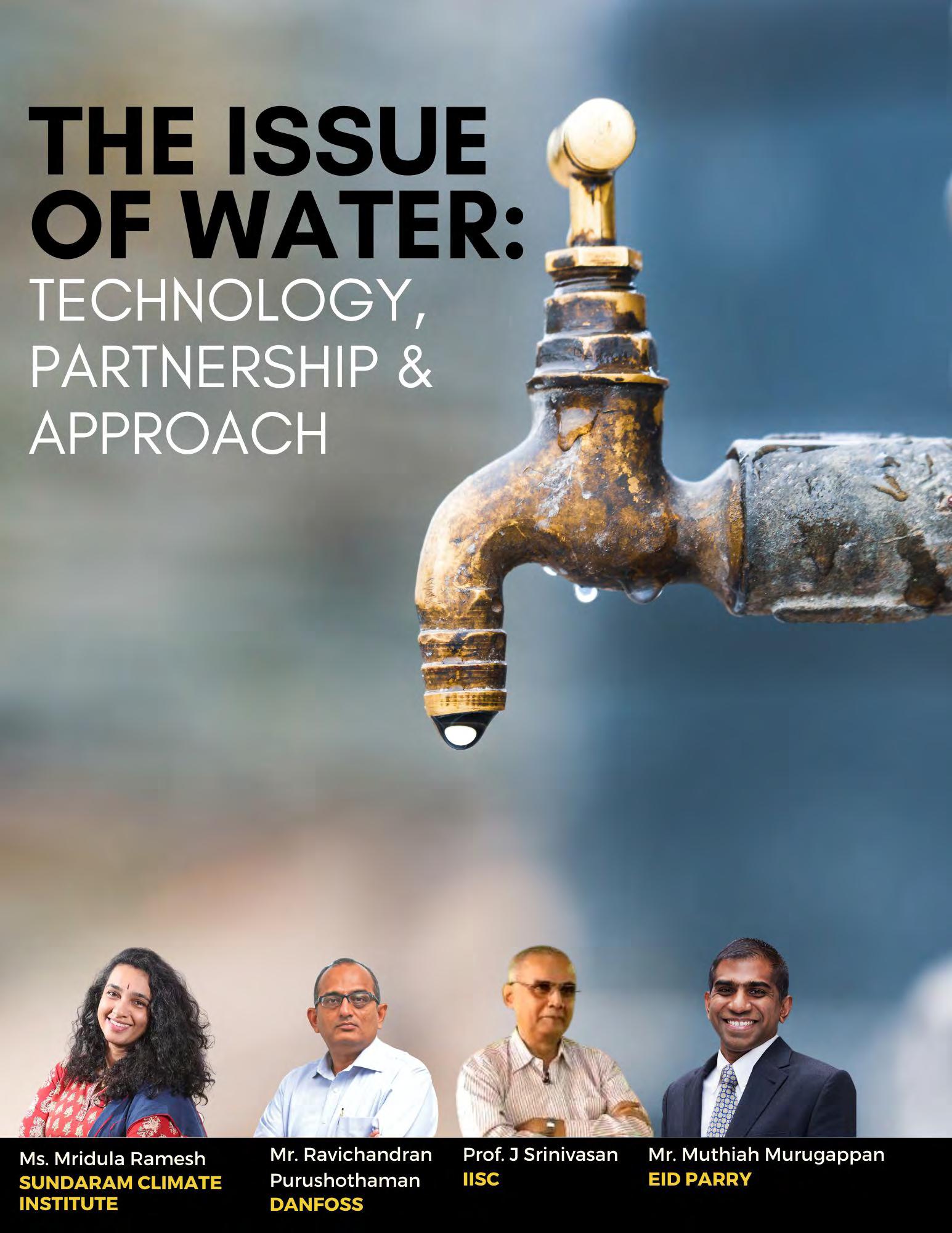
Mr N K Ranganath: There are about 600 to 700 million people in India who face a water risk or have very poor access to water. If we don’t take action now, by 2030, 40% of India will have zero access to water. The demand currently is anywhere between 650 to 675 billion cubic meters. It's expected to double to about 1500 billion cubic meters by 2030. India is moving up the economic scale; we are industrializing and urbanizing at a phenomenal rate. We have an average rainfall of 1200 mm per year. But there is huge variation. In some areas, it's less than three millimeters per year while in some, it is 11,000 mm per year.
There has to be a holistic approach to water. Water for agriculture, water for industry, water for human consumption and water for animal consumption is all one water. We must see how we can effectively share water. The Jal Shakti ministry is an effort in the right direction. But sadly, water is state subject and we have six or seven ministries handling water. We have almost 4000 trillion cubic meters of rainfall precipitation, of which about 2000 is usable. The rest goes here and there. The second issue is storing this for a rainy day
This panel discussion is continuation of last month’s cover story, “How to Make India Water Resilient?”
The panelists were: Ms. Mridula Ramesh, CEO of Sundaram Climate Institute; Mr. Ravichandran Purushothaman, President‐India Region, Danfoss Industries; Mr.J Srinivasan, Distinguished Scientist from IISC Bangalore; and Mr.MuthiahMurugappan, CEO of EID Parry ﴾India﴿ Ltd. Mr. N K Ranganath, Former Managing Director of Grundfos Pumps India Pvt Ltd., moderated the session.
or should we say, non-rainy day? The potable water is reducing
We need to go local and give equitable access of water to all the stakeholders in each area. We know that one-third of India is drought prone and one-tenth of India is flood prone. Two thirds of India has contaminated water. These are all facts. All that we can do is to start reversing this contamination. 80% of India's water is used for agriculture, 10% for industry and 10% for human and animal consumption. We are profligate in the use of water in agriculture. As compared to Vietnam and Indonesia, we produce half the quantity of rice for double the quantity of water per hectare. 10% savings in agricultural water is 8% savings in India's water consumption. It is almost 80% of human consumption for India.
The central government has taken tremendous efforts and invested heavily for water management. They have also come up with a composite water management index which is a brilliant way of stating how well each state is doing. Gujarat and Kerala are right at the top and Tamil Nadu is about six or seven.
It's not about the quantum of water but how well they manage water. In Chennai, 4000 cubic meters of raw sewage is let into the Cooum. They don't have the money to put up the treatment plants. We have to find a way of doing it under the PPP method, like what is happening in the Namami Ganga scheme, etc.
We consume more groundwater than China, US and Israel put together. We also have borewells in each house. We need them because the government is not giving us enough water. Sewage waste is perhaps the greatest source of water. Our cities are now going for recycling and Tamilnadu is doing quite a bit of work. I went and saw some of these. They're doing tertiary treatment and sending water down to the industry.
Let me put some questions to our panel. Mr Muthiah, you have a food-based industry. You make alcohol out of it. In your community and the industry, what are the issues that you're facing? Is there a buy in from the community to work with you?
Mr. Muthiah: Seasonality impacts the business and
the business model. In the hotter months, water is not available. Rainfall varies across years. We wanted to stem that. We actually didn't start with the sugarcane business. We started with the algae business, which is the other realm of foods. We worked on the watershed around the areas of Sivaganga. The local community did get involved but we had to engage them, educate them before getting them involved.
We had to bring in the funding from our own CSR initiatives because it's a very arid region and the communities were not really prosperous to come out and support such an initiative. This work gave confidence to us and to a lot of members of the sugarcane sourcing team here. We've expanded this activity into the sugar cane belt, where the issues are even graver.
First, there was the issue of seasonality around running the factories with a sugarcane belt. Sugarcane is a water guzzler. Of course, it's lucrative for them. We have age old irrigation practices where sugarcane farmers flood the fields and they believe it's the best
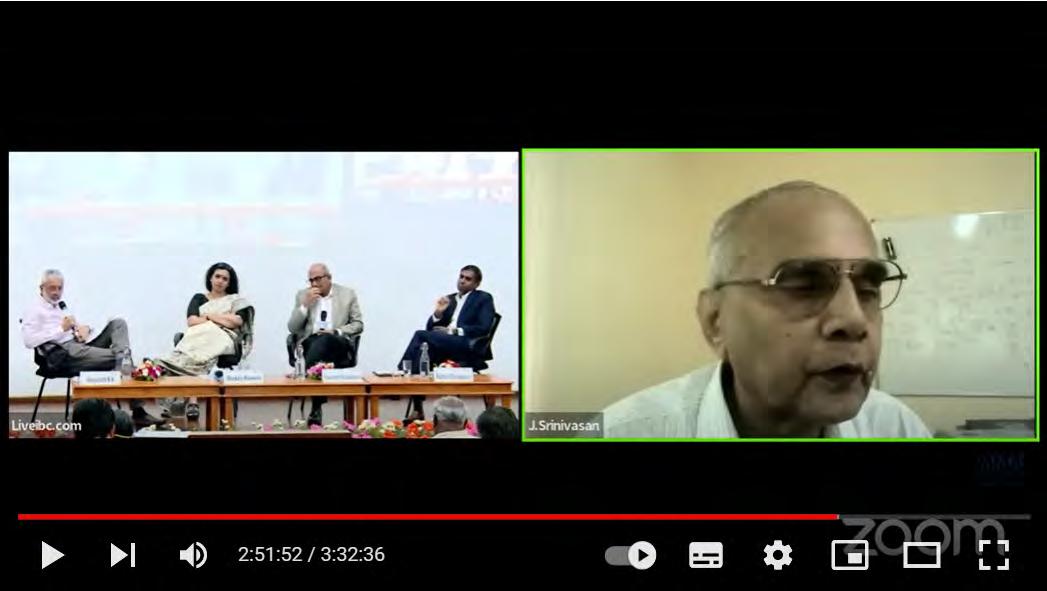
way to irrigate the crop, where in reality, they deplete the water table. To address this, we've expanded into the sugarcane areas as well. In our sugar cane business, we touch close to 200,000 farmers. There's captive CSR funding available, but then we had to go out and start broad basing this funding. We've got good support from the local farming community.
We currently manage about a billion and a half liters of water and the aspiration is to touch 10 billion in three years. We serve marquee FMCG customers like Nestle, GSK and Mondelez. All of them want to participate in these initiatives.
Mr. Ranganath: I'm from a farming background and I know it’s very difficult to change farmers. You have to weave in their traditional knowledge with the new digitalization efforts that have happened. How did you gain acceptance?
Mr. Muthiah: Very true. We follow a progressive farmer concept. Progressive farmers are those farmers who work to stem the ‘flooding of fields’ irrigation concept. We work with agri-tech companies who have IoT based smart irrigation solutions. We use these farmers as advocates, to speak to the larger farming community.
Ms. Mridula: Demand management is lacking in India. There are startups who are taking it on. We have signed up with one of them. They work on precision irrigation using IoT. But startups working in isolation will never solve the problem. Partnership is the name of the game. As the Waterman of India, Dr Rajendra Singh, says, indigenous wisdom is the key to solving India's problem. The Community Connect has disappeared in cities. We need people to come up with innovative ways to solve it. One of the startups I know, puts a robot down the borewell to see how it's working
~ Ms. Mridulaand how to rejuvenate dead borewells.
Mr. Ranganath: Are these startups scalable?
Ms. Mridula: 100%. Five years ago, electric mobility was a joke. Today, the angel investors want to invest in EVs. That is what will happen to water also.
Prof Srinivasan: Often people blame climate change for all our problems. Every Indian city must recognize that they cannot afford to be careless about water conservation. Take Bangalore, for example. It is a very poor example of a city built on a hilltop, nowhere near a river and is growing in size. It takes water from Cauveri, which is 100 kilometres away. Now there are plans to take water from Sharavathi River, if you can believe it.
We need to look at conservation and managing the water demand. There is no place in India where water is in plenty. Delhi has the highest per capita water consumption. To me, the first lesson is that urban areas should be leaders in water conservation and controlling water use, because they are the ones using water much more than the rural areas. Of course, agriculture is a major issue. But I don't see any easy solution in agriculture. As many have pointed out, farming community not going to change that easily. They say, ‘The urban community wastes water and why blame us?’
As the Waterman of India, Dr Rajendra Singh, says, indigenous wisdom is the key to solving India's problem. The Community Connect has disappeared in cities.
Mr. Ravichandran: I represent Danfoss, a company which is into energy efficiency and electrification. We do a lot of work both at the factory and political level. In one of the delegations I was in, one of the MPs asked me, “What business are you in?” I said, “I'm in energy efficiency” “Oh, you're making LED bulbs,” he retorted. It struck me that LED bulbs have made a big impact. How do we take the water tanks to the politicians as the LED bulbs? This is a very important message. We must sell the story of LEDs differently for water. To me, fixing water is fixing tanks.
I come from an agriculture family. Urbanization has driven us away from farming. We have a 50 acre campus in Chennai. When we signed the MOU with the government, they agreed they will give X kilo liters of water per day. When we started operating in 2013, we were 1300 people in the campus. We were spending 165 kilo liters of water per day. We thought that this was too much of water and water is on our balance sheet. We couldn't find a good solution.
Later, in 2017 or 18, we ran into a startup with young boys and they measured where we were spending our water. We focussed on three mantras: reduce, reuse, and renew. I have lived in Germany for many years, along the Rhine River. Germany treats its water six
times before it lets it in the river. Reuse of water is nothing but recycling water. For regeneration, we need to work around the communities. We picked up the villages around Vembakkam, which is a small village of 60,000 people. They never knew they had a lake. We found it out through the Irula community that was living around the periphery of the lake.
We went into the mission mode on cleaning up the lake through the Collector. We had to find houses for the Irula community. We had to find the lake and demarcate it. We engaged with an NGO from Hyderabad, and today we have cleaned the lake. It is about one acre in size and in the last five years, it has brought livelihood for 50,000 people. We need to bring social transformation on ground. I agree with Dr. Rajendra Singh's message that neither the government nor the industry can fix it. Community has to be brought on board. Community engagement is very important. We need to educate and partner with the community. That's the second message. The last one is, we all need to reduce our own consumption. We need to be ambassadors of water and energy, otherwise we will be leaving a very, very poor planet for our next generation.
Ms. Mridula: During the survey done by us in Madurai on water, we asked people, “Why are you not acting?” They said, the government should do it which is a shorthand for saying, ‘I don't want to act.’ Once they realize the power is in their hands, people begin to act. Second, we have become disconnected from our past ancestral wisdom. We have forgotten about it, especially in our cities. So education of what is to be done is very important.
Mr. Ravichandran: Five years ago, we were consuming 165 kilo litres of water in the campus every day. Then we got the team that put the entire IoT solution and we started measuring. We just didn't stop with that. We
Community has to be brought on board. Community engagement is very important. We need to educate and partner with the community.~ Mr.
Ravichandran
started educating our entire community of 1300 people in our company that we are consuming so much amount of water. They came up with many ideas. For instance, one person pointed out that when we served Sambar Rice (Sadam) in the canteen, water consumption was more. We tweaked that and made it as Bisibelabath and water consumption came down. Even small things can bring in a lot of change. If we reduce the water pressure in our houses, a lot of water can be saved. School children must know about conservation practices. So the short term solution is to reduce, reuse and renew. In the medium term, we must look at all our tanks. In the long term, we must look at the feasibility of connecting canals and rivers.
Prof Srinivasan: It is good to talk about water conservation in text books but in India theory and practice are different. We have not merged the two. Every school must measure the amount of water they consume and document it. Then the awareness will increase.
Mr. Ranganath: One good example is a competition organised by Indian Green Building Council for schools on greening. Quite a few students have focused on water and they're being funded to do the job. They actually execute it.
Mr. Ravichandran: We have two different Indias now the urban India and the real Bharat. Migration and urbanization have divided India. The urban part is 50% and the rural part is 50%. We need two different approaches to solve the water problem. The urban centers require deployment of technology. Not many of us know that Koyambedu in Chennai has a sewage treatment plant and it's an energy positive plant, which means it does not consume energy. It generates and uses its own energy.
Technologies are available on how to solve urban problems. Of course, they are all coming from outside of India. We must innovate with startups and do it in an Indian way, at an Indian cost level. The second thing is to look at the real Bharat which is about $1.2 trillion economy. If we can put water back into the Bharat, I'm sure there will be a lot more opportunities for the Bharat to grow.
Mr. Ranganath: We must get all the stakeholders to work together. We must change focus from merely doing activities to creating the required impact in a sustainable manner. For example, I was working on a program in which we revived a few lakes and we thought we had done a great job. Everybody was very happy. One year later, they were back to where they were earlier because what they were like nobody's lakes. The locals did not take them. So we changed our business model and sat with them for two or three years to get their commitment. We also had to look at the larger community around, who had more money, and we got them involved. We have little pockets of excellence in India. We need to tie them together.
It is good to talk about water conservation in text books but in India theory and practice are different. We have not merged the two.
~ Prof. Srinivasan

Ms. Meenakshi: Tell us how sustainability became the flagpole of your career.
Ms. Deepa: I started off with a career in engineering. As a mechanical and electrical engineer, I worked in the building industry and energy efficiency was always an area of interest. Most mechanical and electrical equipment items are the biggest energy guzzlers in any building. From there, I moved on to sustainable development in the US where I worked for the US Code Authority, the International Code Council. I was one of the engineers evaluating new products. In the US, new products have to be approved by the Code Authority before they can come into commercial use in buildings.
In the early 2000s, the US Green Building Council started the Green Movement in buildings globally. They were looking for representatives from the Code Council to be part of that committee. Usually, the newest person on the block gets shoved with all the work and I took it up. Thus, it was more by accident, rather than a planned entry into sustainability.
Women‐driven sustainability projects are bringing in the required change the world over. However, there are dynamic variables that define the path ahead. FLO Chennai in association with MMA & KAS organised a panel discussion. The panellists were: Ms Deepa Sathiaram, Executive Director, En3 Series & Technology Pvt Ltd; MsMeeraNair, Independent Director, DBS Bank India Ltd and Ms Maithreyi Lakshmi Ratan, Founder, Wild Ideas Cooperative Trust. Ms Meenakshi Ramesh, Executive Director, United Way, Chennai, moderated the session.
When I started working with the Green Building Council, a lot of sustainable development ideas and techniques came about. There was so much that could be done in the building industry, which we were not doing. So it became a natural interest for me to develop my knowledge and understanding. We decided to move back to India in 2003, because we wanted to start our own company.
Between 2004 and 2008, most of my time was spent in explaining to people what we do, why we do and why they need us. One of the biggest things when we started working with projects was offering an integrated design because we work in silos in India. The architect does his own design and the electrical guy does his own design. It's not integrated and it's all done with a whole bunch of assumptions. They load a lot of safety factors and this causes excess use of materials and resources. One of the first things in sustainable development is to use less resources. There are 3Ds that I tell people as three mantras and they are: Dematerialization; Deconstruction and Decarbonisation.
Every material comes with a certain carbon emission associated with it. Today in a building, we use on an average, 128 different types of building materials, when you can do it with about 20 to 22 of them The second biggest thing is deconstruction. We're now looking at prefabricated modular based systems. Today, it's all brick and mortar After 30 years, when the purpose of the building changes, we have to demolish and then rebuild it. But if you design buildings that are deconstructible, then they can be removed and replaced It can become very simple All of this leads to decarbonisation. As a global group, we are moving towards zero carbon.
Ms. Meera: My professional experience is largely in the food, agriculture, rural development and financial services. I started my career as a product manager, dealing with branded agrochemicals wherein we designed rural marketing strategies for branded agro chemicals The mantra at that time was right dosage, of the right pesticide, on the right crop. That's what Cynamid India preached. Little did we know at that time
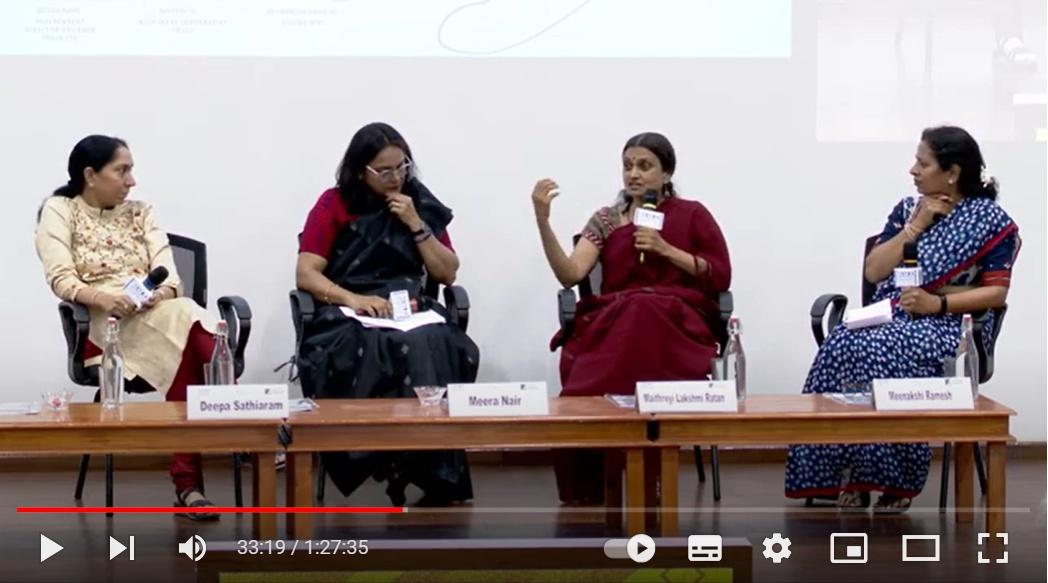
that it was about sustainability. On the output side, I worked on E-trading of agricultural commodities and futures trading of agricultural commodities I was a founding team member of the National Commodities and Derivatives Exchange. We came out with products and markets for agricultural commodity derivatives in India The objective was to come up with efficient price risk management strategies for the entire agricultural value chain, starting from producers, traders, the organizations who dealt with agricultural produce and the end users We set up e-trading platform for Tamil Nadu government. Both e-trading and the futures trading of agricultural commodities are inclusive business models, which help the farmer -the producer to manage price risk efficiently
Another place that I worked with was EID Parry. I was General Manager -Strategic Initiatives. There, I worked on several rural empowerment strategies Our focus was largely to create rural employment in the sugar belt of Tamil Nadu. We created market linkages for farmers. We created rural business initiatives and
created rural entrepreneurs in that process. Today, I work as a strategy and management consultant. I focus on food and agri business. Apart from that, I'm also a business mentor at Stanford Seed and Crescent Incubation Council where I focus largely on the food and agri business startups.
Ms. Maithreyi: Sustainability, as I think about it, is a set of activities. Sustainable activities are things that can be maintained over time, without the erosion of vitality inside and outside. Sustainability is in your everyday life and it is our life force. It's a spiritual one. It is economic, social, cultural and financial. It's in all aspects of being human. Even though the prominence of this term came into being with agriculture and the environment, it is absolutely applicable to every aspect of life. To me, a life that is sustainable is one which does not undermine the basis upon which you live. That is what we practice in Thiruvannamalai through our Wild Ideas Cooperative Trust, to retain that vitality.
Ms. Meenakshi: Deepa, how has your 20 year journey been? Do you think people have come some way and are doing it the right way?
Ms. Deepa: Well, it has changed for the better. There's a lot more awareness at every level. But the
biggest challenge for sustainability in our industry is sustaining sustainability. People will do it once or twice because there's a lot of PR and branding around it. One person maybe passionate about it but when that guy moves off, you see that the interest drops over time. Doing things slightly better is definitely progress. But it reaches a point where you have to be more disruptive about how you want to do it. We're not seeing that yet.
Ms. Meenakshi: Meera, tell us how sustainability as a term is now more important than ever before in the food sector.
Ms. Meera: There are three main important reasons why the food and agricultural space needs sustainability. One is the growing population. By 2050, the global population will be around 9.8 billion. We need to feed this growing population. According to a World Food Programme report, we have about 828 million people going hungry every day. We have to take care of the hunger levels. This is the first problem.
Secondly, there's a lot of food wastage happening. One third of the total food that is produced across the globe goes waste. That can feed 1.3 billion people. In India, about 40% of the food that is produced goes waste and that's a huge number. Thirdly, if you look at the household food wastage, it's about 50 kilograms per person annually. That is 68 million tons. The fourth and a very important thing is that food production increases greenhouse gases in the environment. Greenhouse gases deteriorate the amount of food that is produced. It's a paradox. How will you be able to overcome this paradox and produce food that is sufficient for 9.8 billion people sustainably? This means the current resources should be effectively used, so that it can be either enhanced or it can remain the same for
To me, a life that is sustainable is one which does not undermine the basis upon which you live.
~ Ms Maithreyi
future generations too. These are the four aspects that have to be looked at when you think about food and sustainability.
Ms. Maithreyi: I'm an organic farmer. The first thing we do around sustainability is to provide livelihoods for women and men locally. In agriculture, once we bring in machines, people lose work. The inputs they put in the soil are so harmful that within one generation, they can't grow and they don't have seasonal work. To address these issues of employability or sustenance of feeding their families, we started rural enterprises in Thiruvannamalai for local people with very simple things to address sustainability. The products have to be consciously made with local materials and with complete traceability from farm and forest. In terms of a business, we have to be sustainable. We have to be regulated and there are compliances.
When we asked the women we're giving work, “What is it that you aim for, apart from predictable income?” they all said, “Peace.” Contentment is something they aspire for. It's easier for us to work in the areas of sustainability when greed doesn't come in.
The moment you've crossed a certain barrier, then there are resource compromises. The person is no longer considered a human being but a unit of
productivity. In Thiruvannamalai, we help people get work that they love doing for eight hours a day. We set up rural enterprises in the organic farming. We have started rural livelihood programs in the construction industry to stem urban migration. It's called workflow.
Ms. Meenakshi: Deepa, you talked about 3Ds. Is it happening in the large building industry?
Ms. Deepa: The attitudes are changing, but the infrastructure hasn't yet caught up with that. We lack the R&D and the ecosystem for making traditional building materials in India. Almost 50 to 60% of the materials that go into a building are imported. A good portion comes from China. For example, before the pandemic, a small scale industry person came down to our office and said he makes wooden looking flooring from paddy rice husk waste. The sample was fabulous. It was entirely handmade. I said, “Great. Can you supply 10,000 square feet for a project?” He said it would take him six months. We don't lack talent, ideas or people. What we lack is an ecosystem to guide people both financially and also to create a commercial product.
In the West, most of the great products or innovations happen in the universities. Companies have connections in colleges and that's how the Stanfords and the Harvards became famous. We don't have that ecosystem, unfortunately. IIT is trying to do that with some success. But for a country like India, one institute trying to do that is going to take a long time. We don't have the financial infrastructure and incentives to do that. A lot of those things are yet to fall in place. There are a lot of knowledgeable people in my industry. It is just that you have to tap knowledge and convert that into products, technologies, ideas and designs, which will then help us move forward in the low carbon
The attitudes are changing, but the infrastructure hasn't yet caught up with that.
~ Ms Deepa
journey.
Ms. Meenakshi: What would it take to put something like this on the Make-in-India list? We are going to make our own chips. We make our own trains.
Ms. Deepa: Make-in-India is yet to gain traction in the construction industry. I worked a lot in the US. I sit in a lot of committees for the Green Building Councils. The first thing I tell is that today we're learning sustainability from a society that doesn't know how to be sustainable. Traditionally India and to some extent, China have probably been the most sustainable and evolved societies. We lost our way when we sort of aped the West in many things. There are some pluses and minuses. But it's time to start rethinking. You have to take some of your old science and ideas but wrap them in new products and designs, because nobody wants that old look or feel anymore. Every building that we design is the same fundamental science that was used 100,000 years ago.
For example, one of the biggest techniques that works to cut out heat in a building is thermal masking. Our ancient forts and temples have two feet or three feet stone walls. Stone was available locally, so they used stone. Now nobody wants to build a two feet wall. If I tell that to a builder, he'll say, ‘My FSI is gone.’ One of the things that we have put up to CMDA is not to count the thick walls in the FSI calculations. These are things that regulations can help. I don't think anybody is against cutting down heat. If I spend 100 rupees more for the wall, I can save 1000 rupees in my AC cost.
Ms. Meenakshi: Meera, are things changing in agriculture, because there is a lot of awareness or at least publicity about how, for example, Punjab should never have grown rice, because it's such a water intensive crop and there is no groundwater in so many
All of us here are consumers. So we need to adopt sustainability in our everyday life.
~ Ms Meeraparts of the country. What do you think are sustainability trends?
Ms. Meera: All of us here are consumers. So we need to adopt sustainability in our everyday life, something that our grandmothers were doing every day—reduce, reuse and recycle, whether it is clothes, food or anything else. The leftover idlis would be converted to idli uppuma. Food was served on plantain leaves. Those leaves were put outside as waste and they were eaten by the cattle.
In general, the level of awareness about sustainability is increasing. There's a lot of hype. We have UN SDGs. Years ago, India was a land of deficiency. We did not have enough food grains to feed our own people and we were importing food grains. So in the 50s and 60s, we had green revolution and white revolution and produced more rice and wheat. We started using more fertilizers and water resources. The water table went down. Because of cultivating water intensive crops like paddy, the greenhouse gas emissions have also increased.
We need policy initiatives. We need to move from crops like rice and wheat to high value horticultural crops. This is the year of millets. We are propagating cultivation of millets. As consumers, we also need to take a step forward and start moving from what is
available near us and start consuming it. We need to make changes in our dietary patterns.
Ms. Meenakshi: My husband and I went to a session of well-known dietitian Rujuta Diwekar, and she said, “Eat what your grandmother ate and you will be healthy.”
Ms. Maithreyi: The work we do can broadly be categorized into four areas. One is around livelihood creation. That is to get people work close to home so they can feed their families and they don't have to go far away to do so. We do that by creating rural enterprises. Just because we sit in rural India, it doesn't mean we can't create world class enterprises. That was my fundamental philosophy. Within these nine years, our challenges have been many in the areas of infrastructure, compliances, policies, loans and subsidies.
The second vertical that we explore is around social and cultural sustainability. This involves having families not getting fragmented. Everyone is tied to where they're from. We'd like to retain that which gives them happiness. So education is a big part of what we focus on- not just in terms of attending a school, but offering holistic education. Our work takes us to every village where we run educational programs for children up to
their college level and up to employability.
The third piece is health. I come from an urban setup. So I don't understood many things. The best way to learn is to sit with rural women and men in a circle and ask them what keeps them up at night. They came up with a list and the list had livelihood creation, education and debt because of health related issues. Because of the food we eat and the lifestyles we have now, people go into severe debt. They can't go to hospitals and come out without an atrocious bill. We organise health check-ups. It's always important to think about how you can stop the problem in the first place and with preventive medicines.
Simplicity is never respected but complexity is liked. We're trying to go simple. We're trying to get 94 herbs. We take these herbs to dispensaries where we get older people who are disenfranchised socially. No one wants to talk to them. They'd rather talk to Google and the TV. We want to run a social experiment to get respect back to our elderly. In the next three to four years, we'll start growing forests. That's a big part of what we want to do.
Ms. Deepa: One of the biggest challenges going forward is the rapid urbanization issue. More and more people migrate from villages and small towns because of lack of livelihoods and our cities are in no position to take that. Urbanization will lead to carbon emissions, which will lead to more greenhouse gas emissions, which in turn will affect agricultural industry and which in turn is going to impact livelihoods. It's a vicious circle. When you disturb the balance, this is what happens.
Ms. Meenakshi: What do you think are the unique contributions that women can make in the field of sustainability?
Just because we sit in rural India, it doesn't mean we can't create world class enterprises. That was my fundamental philosophy.
~ Ms Maithreyi
Ms. Meera: You should start from your house. Not only women, but the men also need to be involved. Reduce, reuse and recycle. You must start this from your home.
Ms. Deepa: Sustainability is a very cultural thing, because it's something that you have to imbibe. The source of this culture will only come from the women in any institution, any household or anywhere. Education and culture are again women driven. Globally, women, I would say, are three times more involved with sustainability than men, probably because we resonate to it and connect with it better.
Ms. Meenakshi: How does gender inequality intersect with environmental issues?
Ms. Deepa: Women are probably the most affected because of climate change issues globally. A lot of livelihoods and women based activities are the most affected because of climate change. ESG Environmental, Social, and Governance—is now a corporate mantra. When we talk of sustainability, still a lot goes under the environmental bucket. Social includes gender equality, gender balance, diversity and inclusivity. Governance includes both corporate governance as well as regulatory frameworks. There is a lot of push and thrust now in the environmental aspect of ESG and at least some progress has happened. In the social side, there's very little impact that's seen. It's not just about gender equality.
Ms. Meera: We must move away from mono cropping to diversified multiple cropping systems. Think about aforestation rather than deforestation. Look at drip irrigation facilities rather than using fertilizers across the board. Create livelihood opportunities, social networks and rural entrepreneurs. These rural entrepreneurs, in turn, can take the lead in
developing various things around the farmland and the agricultural sector.
There must be policy initiatives to promote multiple cropping systems and to reduce food waste. We can give subsidized money and sops for building agricultural infrastructure that includes storage facilities. We must support those coming out with sustainable solutions in building cold storage facilities and transporting fruits and vegetables.
Ms. Maithreyi: It's very important to stay local. The local can be a radius of 200 kilometres. It doesn't matter. But it doesn't have to be apples from New Zealand.
Ms. Meenaksi: How supportive is your family in this pursuit of sustainability?
Ms. Maithreyi: We live our life. We're a family that's living a conscious life. That's all. We have cattle. We have five cows. We grow our own food. My son is 15. He grows his own rice. We have a farm where we grow our stuff including millets and vegetables. My husband does a lot of work with Chettinad egg-lime plaster (which is a zero carbon material).
Ms. Meenakshi: I read an article about microplastics. Apparently, your facewash has microplastics. They just get washed down the drain. It flows into the ocean
Women are probably the most affected because of climate change issues globally.
~ Ms Deepa
because the vast majority of our sewage is not treated. Then they get ingested into marine life. So let's all become more conscious and I think that is the first step. Perhaps real change will happen over a couple of generations. I am an eternal optimist. I truly believe that the next gen smart kids will pull us back. Can you all take us through a women-driven sustainability project that you were involved with?
Ms. Deepa: We worked with a project in Indonesia. A group of women from the fishing community went out into the ocean to take all the fishing nets that get left behind in the ocean. Through a community initiative, they removed the fiber out of all of these fishing nets, which was then given to a company that made carpets. It was like using a local community, which was entirely women driven. They made money out of it, though it was not big. One of the biggest challenges for any rural initiative is scalability and repeatability. A lot of good things get done in pockets but we're not able to create a scalable model.
Ms. Meera: Let me talk about what happened in our housing society. Till two years back, we were not segregating waste. But Chennai Corporation came up with a rule saying we have to segregate waste. In our complex, we have 350 apartments. So they said that collecting waste from your apartment will not be done unless you segregate waste.
The women in our complex came forward and I was not one among them. I just saw what was happening from backstage. They came up and found out how it was done elsewhere. They clearly decided the rules. They just copied it from other societies where it was happening and told us how to segregate the food waste, the plastic waste, etc. If this initiative had been taken by the men, women in the household would not have agreed.
Ms. Maithreyi: ‘Wild Ideas’ was my first baby. I told Ranjitha, a woman who was not formally educated that we're going to make products. Capacity building with a Stanford grad is very different from capacity building with my Ranjita who asked me, “Why are you asking me to do this?” But the ability for women to learn and adapt, especially when it comes to taking care of their families is just amazing. All our products are designed based on colour codes, because our women can't read.
The first time we set up a bank account for Ranjita, she asked, “Okay, now what do I do?” I said, “You have to put your money and you can withdraw this money.” She said, “Why do they need my money? I can keep it under my pillow.” “No, no. Every month, we're going to give you money,” I told her and she agreed.
We trained her to go to the bank. She went straight to the bank manager and said, “You have my money. Give it to me right now.” I was sitting there laughing. That is not the way to talk to a manager, but she doesn't know. Then there is the other story of a woman who had never been to a school. She's an orphan. She works with us. She said she wants to be the person taking the phone call for the orders. I trained her to pick up the phone and when she said with ease, “Welcome to Wild Ideas” with a pride on her face that she's running the enterprise, sitting in rural Thiruvannamalai, I was in tears.
Ms. Meera: We talked about support by the family. Sometimes you may have a supportive family. Many times you may not have a supportive family. But how will the family support you, unless you stand up and ask for it? As women, we need to stand up and talk for ourselves. Only then, we'll have a supportive family who will understand us.
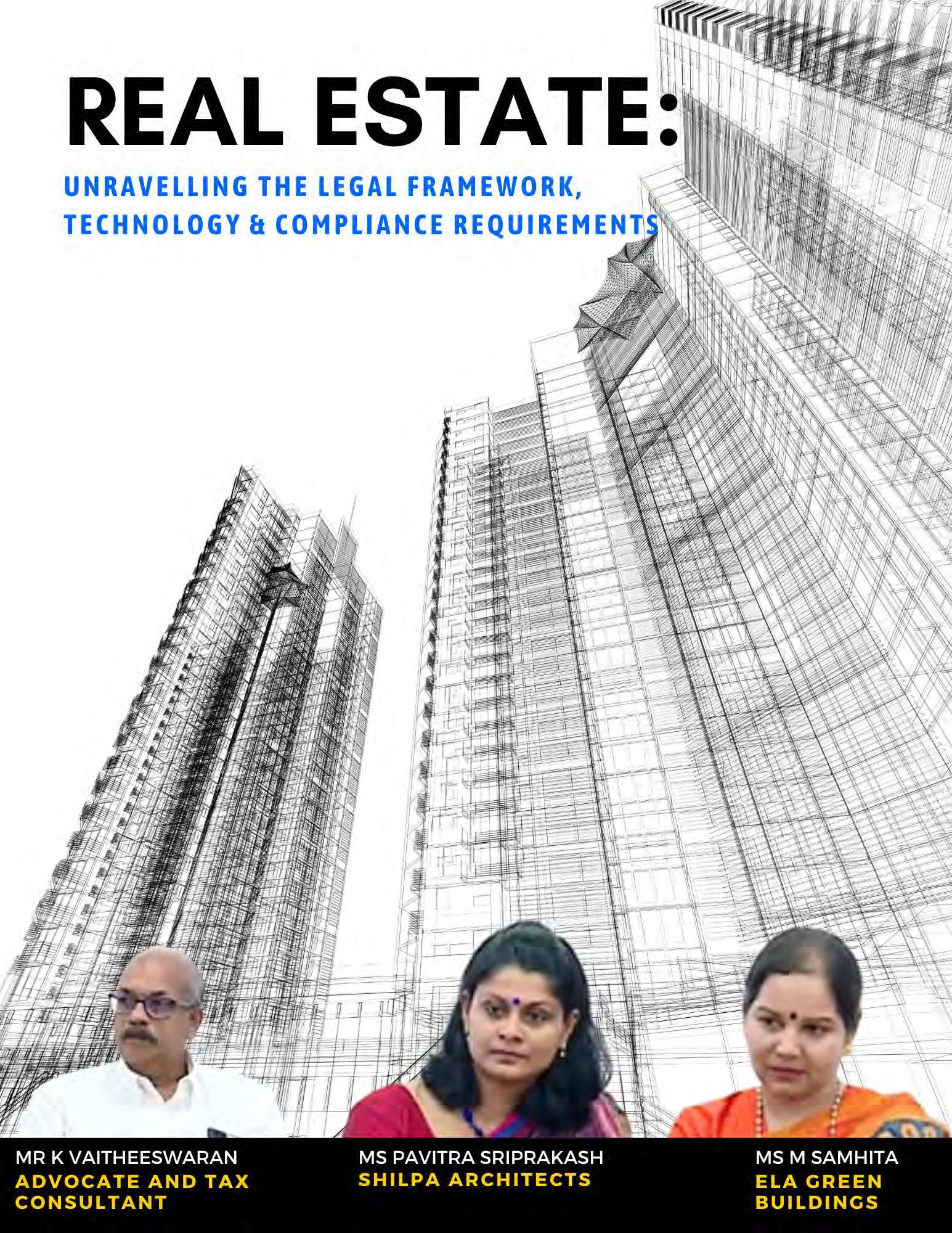
In the pre-RERA period, there was rampant misspelling and wrong selling by a set of people. Of course, there were brilliant, genuine players across the industry, but the sector got a very bad name because of some unscrupulous and unorganized players. There were inordinate delays in delivery, issues of non-conformance to specifications, diversion of funds collected for the projects, and so on. Therefore, the Parliament felt that we need a law that completely regulates the sector, though there have been constant debates as to why you should need a law for one specific sector.
The objective of RERA is to create an authority for the regulation and promotion of real estate; bring in efficiency and transparency in the sale of real estate projects; protect the interest of consumers; and establish an effective adjudication and speedy dispute
Real estate, being the second highest employment generating sector, holds significant importance in India, which is poised to become the third largest construction market in the world. However, this sector faces numerous challenges and issues.
redressal mechanism. It applies to the whole of India except Jammu and Kashmir. When the law was being mooted, the Minister for Urban Development said that the real estate bill seeks to form a happy alliance between buyers and developers and that it addresses the complexities of the sector by putting in place a regulatory mechanism.
There are many developers who are guided by principles and ethics. That is why these companies are shining better. There are thousands of players in the real estate sector compared to only five or six players in the telecom sector. That was the justification of the minister for having a regulatory mechanism exclusively for the real estate sector.
RERA covers the development of land into plots or apartments as the case may be. A building may consist of apartments, which also includes the conversion of existing buildings into apartments. Redevelopment also comes under the Act. So it is important to understand that it is not just for a new project. According to RERA, the promoter is responsible, liable, and accountable. If you're not developing for the purpose of selling, then
you would not qualify as a promoter. A development authority such as a Cooperative Housing Society is also identified as a promoter.
Why is RERA significant today? A builder talks to a consumer through advertisements and people are lured by them. Now RERA says that no advertising or marketing or booking or selling or offering or inviting to purchase by a promoter can happen unless the project is registered with RERA. In the ad, the consumer can look at the RERA Registration number. If you go to the RERA website and feed that number, you will get the entire details of the project. The biggest advantage is transparency for consumers as every data about the project can be seen on the website.
Where the development is in phases, each phase is considered a standalone project requiring registration. In case there is an ongoing project where the construction certificate is not issued at the time of the commencement of the Act, registration must happen within three months. An application for registration is very comprehensive. RERA takes care of the consumer
side and the builder side. It helps the consumer in getting the right product. The developer must give all the information in the application, which is very comprehensive and requests for authentic information and data.
RERA has an adjudicating process. Let us say an order is passed. You can appeal against the order to the adjudicating authority and escalate it to RERA appellate tribunal. RERA must publish and maintain a website of records for public viewing of all projects listed. On the website, you can see everything about the project and also about the promoter. You can know their past history, about delays or deficiency in development and delivery. RERA maintains a database for public viewing and enters names and photos of promoters who are defaulters. Even a real estate agent cannot sell a project that is not registered, and the agent must also be registered.

RERA gets its teeth when somebody lodges a complaint. It can also, suo moto, call a promoter if it comes across discrepancies or default. It can also help
the promoters, when there is a default by the allottees. It has all the powers of a civil court under the CPC plus it has the power to issue interim orders. It can issue directions, and such directions shall be binding on all concerned. The consumer can knock on the doors of RERA if something that is promised is not delivered.
RERA registration presupposes that the promoter has got all other approvals in place. The promoter must provide the development plan and details of all the facilities being offered. The location details of the project with clear demarcation of land dedicated to the project along with boundaries must be provided. They are now bringing more technology into it whereby it's getting absolutely transparent. The entire land of the country is going to be mapped.
RERA has brought a new concept of carpet area. It is the living area in an apartment and excludes common areas, walls, and balconies. The promoter must give a declaration that he has the legal title to the land on which development is proposed.
RERA says you must finish the project within the time you commit. The most important and interesting
aspect of RERA is that 70% of the amount realized for the project has to be deposited in a separate account in a scheduled bank. This is where it ensures that funds received for one project are not misused for another purpose. Therefore, this is a very powerful and effective tool. You can withdraw money as and when the percentage of completion increases, and for that what is required is a certificate by an engineer, a certificate by an architect, and a certificate by a chartered accountant to the effect that the withdrawal is in proportion to the percentage of completion of the project. The accounts have to be out within six months or at the end of every financial year, and the statement is required from the CA to the effect that amounts collected for a particular project have been utilized for that project and withdrawal is in compliance with the proportion to the percentage of completion. This places all the more responsibility on the Chartered Accountant certifying a project.
RERA registration is not required when the land to be developed does not exceed 500 square meters or the number of apartments proposed to be developed does not exceed eight, including all phases. Also, if you have obtained a completion certificate prior to the commencement of the act, you don’t come under RERA. The Act also says that the authority, within a period of 30 days from the date of receipt of the application, must either grant registration or reject the application. Once registered, the authority shall provide a registration number, login ID, and password for accessing the website. If there is a failure to grant the registration or in the case of failure to reject the application within 30 days, it shall be deemed to have been registered. This puts pressure on RERA to issue registration.
RERA registration presupposes that the promoter has got all other approvals in place. The promoter must provide the development plan and details of all the facilities being offered.
You can always extend your project timeline if you're able to demonstrate force majeure conditions that affected the project. During the COVID time, a lot of people were able to get the extension. RERA themselves voluntarily granted an extension. If a registration is revoked, the authority will debar the promoter from accessing the website in relation to that project and specify his name in the list of defaulters, display his photo, and also inform RERA in other states. This is very, very dangerous. So you can't afford to missell, and you can't afford not to deliver.
No major additions or alterations to the approved and sanction plan can be done unless you get the written consent of at least two-thirds of the allottees, other than the promoters.
RERA can direct the bank holding the project account to freeze the account and take further action to facilitate remaining development. But if you look at it practically, RERA’s aim is not to stop a project. Their endeavour is to ensure that the project is completed. They go out of their way to see how a settlement can be arrived at, involving the landowner, consumer, and developer, as the case may be, and in some cases, all three are involved.
In the real estate business, stamp duty registrations are state-specific. Unfortunately, RERA is a parliamentary law, and there are some inherent conflicts in respect of registration as per the state-level practices and what is stipulated by RERA.
Also, you cannot collect more than 10% of the cost of the apartment unless you enter into a written agreement for sale and register the agreement. Nobody wants to register a sale agreement. The construction agreement must be mandatorily registered. While the
law stipulates that the promoter must get insurance for the title, it is impossible to get title insurance from an insurance company. These are some of the failures of the Act. RERA uses the word completion certificate. In most states, there is no completion certificate. They have an occupancy certificate in some states, but CC is a concept even in GST, but CC doesn't exist in most parts of the country.
If a promoter does not register the project, a penalty of up to 10% of the estimated cost of the real estate project can be levied. If that order is violated or even after the order, registration is not done, it can lead to imprisonment for up to three years. That is the kind of power that RERA has. For false information or giving controversial information in the application, the promoter can be levied a penalty of up to 5% of the estimated cost of the real estate project. These are all the consequences, which a real estate agent and a promoter face for failure to comply with the order or direction of RERA. There is a penalty every day, which may be cumulatively extended up to 5% of the estimated cost. These are all quite stringent and strict penalties, and the pressure is to make you comply.
Unfortunately, RERA is a parliamentary law, and there are some inherent conflicts in respect of registration as per the state‐level practices and what is stipulated by RERA.
Where do promoters mess up? They over-promise and under deliver. They promise delivery dates which are practically not possible. The biggest challenge in real estate projects is funding. After complying with all requirements, they need funding. If NBFCs get into a problem, it impacts the real estate market immediately. Banks have a very vague approach to real estate projects. Some of the banks are very encouraging, and some of them are extremely discouraging. So funding is a huge challenge. What is the solution?
Old loan settlement, IPOs, and REITs are new solutions that are coming into the market. Of course, overseas investors can always walk in with nonconvertible debentures. The second major issue is the inventory of unsold buildings, even after complying with all requirements. If we look at unsold stock in terms of units and apartments, in Q4 of 21-22, in Chennai, the unsold stock was 75,064 units. In Q4 of 22-23, it was 74,008 units. There is always a significant pileup of unsold stock that the builder deals with, and substantial money is lost here. There are always so many pain points in the real estate business. The prerequisite for RERA registration is comprehensive planning and obtaining permission from several authorities. All of these lead to a huge increase in cost. Delays in obtaining permissions and NOC from other agencies can affect the registration. Then there is litigation. If somebody files a petition and a court admits it, it’s the end of the story. RERA could have been a single window, but it has become an additional window.
Today, all states and UTs have notified RERA, except Nagaland. 32 states have set up the RERA
authority, and 28 states have set up their appellate tribunal. Regulatory authorities of 30 states have operationalized their websites. So far, 1,08,208 real estate projects have been registered so far, and in Tamil Nadu, 16,640 projects have been registered. The number of agents registered is 77,525 agents, of which Tamil Nadu’s share is 2,870. A total of 1,11,098 complaints have been received, and the maximum complaints have come from Uttar Pradesh.
To conclude, the real estate sector is in for good times, thanks to the transparency that RERA has brought in.
Typically, in an architectural or real estate project, the architectural work happens before we break ground. A lot of the tech tools that I manage or work with on a daily basis happen to be at the design stage. Right now, we are experimenting with AI and Blockchain. We were fairly early adopters of trying to work with BIMs (Building Information Management Systems), but AI and Blockchain are things that are much newer, even for us. So we're dabbling with tech, once the project is tendered.
When it goes into implementation, we find that there are many construction methodologies of new technology, which are prevalent in the market today. These help in making buildings faster and more efficiently, in monitoring them better, and in giving realtime data as to what's going on site versus what's
planned on the design front. Finally, operations and maintenance of buildings are highly tech-enabled nowadays, which can help in maintaining the building, throughout its lifecycle.
On the construction side, we have technology such as MIVAN, which is aluminium formwork that helps people construct faster. Many developers embrace this, because this is a very easily repeatable format and can help people cut down their construction time. We also have GFRC panels, 3D modulars, and precast. We are able to come up with climate-sensitive, geo-sensitive, and culturally sensitive designs that help us create a more sustainable product. Thanks to digital marketing, visioning of approved projects becomes a lot easier now. We work with the metaverse and gamified realms, and as everyone has predicted, the better you are at playing games, the easier you will find getting work done. Real-time game engines are coming into the space of architectural design and visioning. So if I can dream it, I can probably get it translated into a digital image. Rather than 2D plans, such digital images delight a customer.
We use AI tools to tell us things like how much daylight is coming into the building; are we planning enough lights or are we planning enough ACs? All these can be simulated and given to us in real-time data. You can use ChatGPT to figure out the description of the building and use it in the AI for the design of the building. We tend to run into a lot of budgeting and cost overruns, and value engineering at design is important. You can manage complex and large projects by loading all the information that exists in a very transparent space, for everyone to be able to access. So we can do things like having smart contracts, enforcing
You can manage complex and large projects by loading all the information that exists in a very transparent space, for everyone to be able to access.
the project scope, eliminate processing fees, etc. Basically, we're looking at rapid construction, and time is money. We use Glass Fiber Reinforced Gypsum (GFRC) panels. This is basically like a drywall system. It can be pre-loaded and made into a panel offsite. It can be brought and quickly assembled. Modular and precast systems have been around for a while. The other one is the light gauge steel frame.
MIVAN is a commercial brand name for aluminium formwork. What this means is that every floor of a building can be made into a mould and poured with concrete. Once this is done, you can take it to the next level. As long as every floor of the building is the same, you can use MIVAN beautifully. It cuts down the curing time, and it doesn't have to be 21 days per floor to move to the next level. It's really a rapid way of constructing.
The next part is monitoring the work that is going on at the site. We have many new apps that are coming up, which help project managers to track the project, monitor the attendance of workers and their efficiencies. You can track everything remotely. You can have an integrated design project where all team
members sit in various parts of the world, but they're still able to track that one project. We'll also tie into the part where the auditors come in, making payments and managing the budgets. The digital twin technology is tied in with both BIMs and the modelling software. A digital twin using AI-based visualization software is loaded completely with the data of the building to be constructed, but it exists virtually.
Some of the new products tend to harness renewable energy from either solar sources or from people walking on them. Sensor-based intervention for water efficiency has been around for a while. Now we are pushing this envelope to control the environment of the entire building. We have temperature monitors, humidity sensors, and CO2 monitoring systems. All these things can be linked to the Integrated Building Management System or IBMS. This then functions with the digital twin, dishes out data about the actual efficiencies on a daily basis, and helps you manage the dashboard.
Ms M Samhita Managing Director, Ela Green BuildingsSustainability relies heavily on technology today. People often get confused when we talk about a sustainable building. They think it must have red brick or rammed earth or something like that. But today, we build millions of square feet in a span of a year or less than that. In that scenario, technology becomes very critical to bring in concepts of green, efficiency and climate-responsive design. For sustainable buildings, there are three phases we must look at—design, construction, and operation.
There's a lot of push from the global market as well as our country’s leadership to achieve net zero. We're
There are many tools that are available today for airflow modeling and other energy‐efficient design. Tamil Nadu has notified the energy conservation building code made by the Bureau of Energy Efficiency.
working on green and climate-resilient buildings. Just one or two initiatives in a building like rainwater harvesting will not suffice. We need a holistic approach. We have rating systems and tools to define green buildings. The rating systems have been in place globally for a while. From the early 2000s, India slowly started adopting green building rating systems. Today, we have billions of square feet that are certified green. We have the Indian Green Building Council (IGBC) and LEED, which is Leadership for Energy and Environmental Design. The new ratings focus on the environment and also the people using the space, because that has raised more concerns post the pandemic, on building health and safety.
The next important part is Codes. In fact, India did not have an energy code for buildings until recently. It was in 2007 when the first code was developed by India. Not all of the entire country is following codes. While the rating system is a voluntary approach, compliance with codes is mandatory.
There are many tools that are available today for airflow modeling and other energy-efficient design. Tamil Nadu has notified the energy conservation
building code made by the Bureau of Energy Efficiency. It is still not included in the combined building rules. The implementation is still pending. It is important for designers to incorporate that.
We have many case studies of how various tools have helped us. We designed a small building of about 30,000 square feet in Nungambakkam, Chennai. We worked closely with the architect, and he asked us to come up with suggestions. Very rarely does that happen for us as consultants. Normally the design is frozen, and we are expected to work backward. We created the energy model, did a couple of iterations—one with the solar canopy and without a solar canopy, worked out various cases with high-performance glass with shading devices and without shading devices, with regular bricks and with concrete blocks and so on.
In all, we did nine cases. We could bring down the consumption from 954 megawatt-hours per annum in the worst-case scenario to 459 megawatt-hours per annum in the best-case scenario. Considering the cost involved, we settled for an optimum solution whereby we could achieve 620 megawatt-hours per annum. In the energy bill, Rs.4 lakhs was saved every month. This is the kind of impact that an energy simulation tool can give us.
100% of construction waste can be diverted or recycled, and it can be managed properly on-site. There are simple ways in which we can do it. One is, prior to construction, how do we ensure that the site can be prepared in such a fashion where we minimize pollution control, where we don't have to trouble the other neighbouring sites? During construction, waste management and resource optimization are important. You can buy treated water from neighbouring sites and
use it for spraying on the roadway, so that you don't generate too much dust.
Using precast and dry construction/factory-made panels that are coming now, we can reduce waste. All this must be planned at the design stage, because the structural elements are fixed at the design stage. We can engage recycling agents and vendors who can reuse the waste materials generated on-site.
What gets measured only can get improved; otherwise, we don't know where we stand. So technology has become very important here. We're looking at a data-driven approach to enhance performance, and the most critical path is having a building monitoring system, where you can monitor not only energy or water consumption but also CO2, humidity, temperature, occupant well-being, satisfaction, and so many other parameters. Through continuous monitoring, we will be able to plug the leakages and improve the performance when there's a shortfall in performance. We can even calculate how much of GHG emissions can be reduced as a result of the interventions.
In the Technical Session-3, CA V Prasanna Krishnan gave a presentation on the various GST issues in Real Estate sector. CA L Srikaanth, in Technical Session-4 spoke on the Accounting related aspects of Real Estate. In the Technical Session-5, CA T G Suresh gave an insight into Direct Taxes scenario in the Real Estate.
next important part is Codes. In fact, India did not have an energy code for buildings until recently.
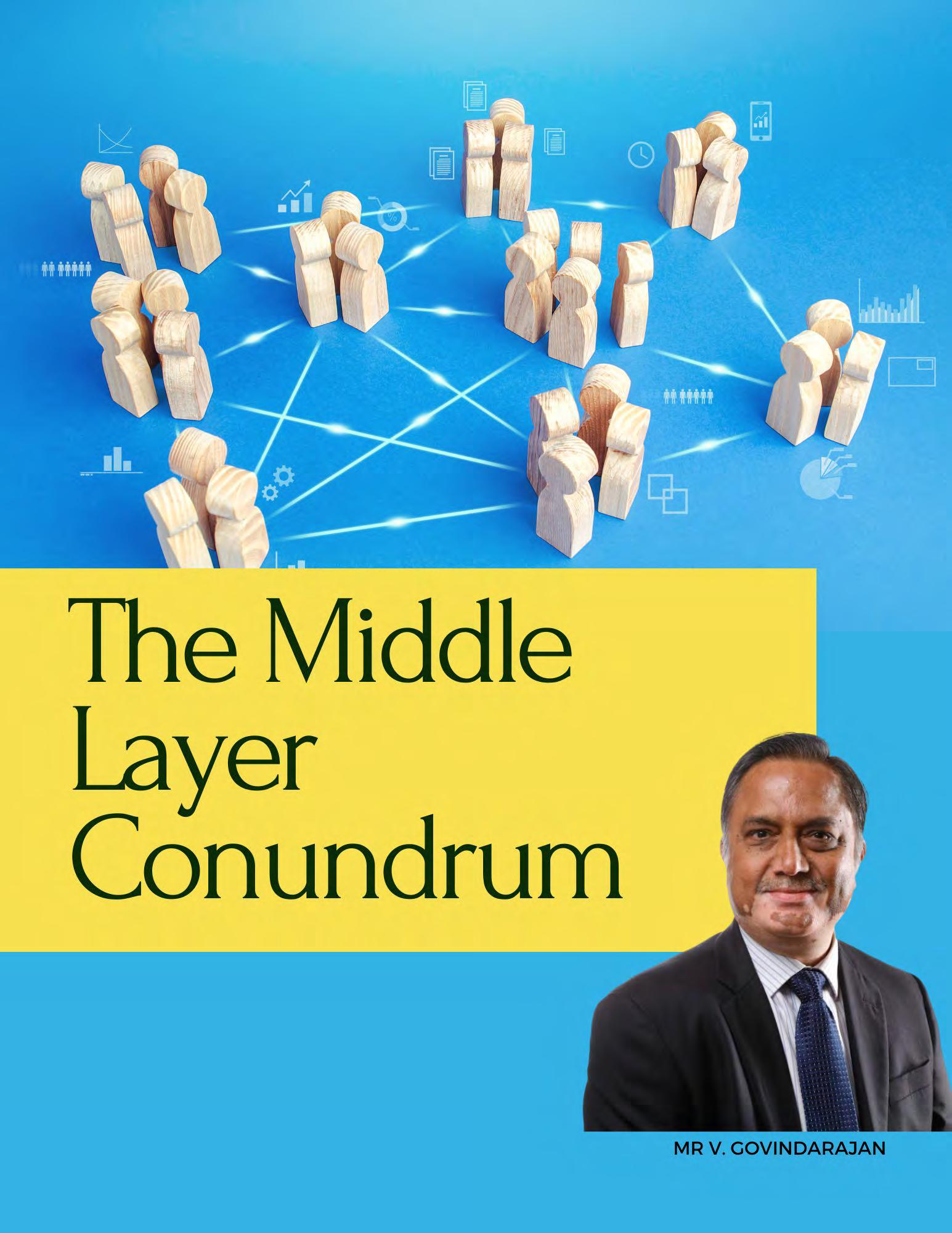 V. GOVINDARAJAN
V. GOVINDARAJAN
Constantly emerging external business trends/ needs drive every business identity to rejig their existing organization structure leading to internal disruptions, misunderstandings etc. Quite often the sarcasm sets in. “Hi, one more circular” is a common comment at the coffee table. Intensity of impact varies from the size of the organization and the extent of changes that are being pushed through. Perceptions vary across the teams, particularly if the company is big and spread across multiple geographies. In spite of best intentions/efforts, the actual outcome or the effectiveness of these changes often fail to yield the desired results.
Depending on the position of the company in the market one may try to pioneer new solutions into the market to establish leadership, and another company may be keen to catch up quickly by pushing in competing products/services. In both scenarios, often external resources (considered as domain experts) are
Questions are now being raised on the usefulness of middle layer “experts"—hailed till yesterday as the “best‐in‐class.”
taken on-board either through a fixed term contract/ permanent employment. New roles are created and those who occupy these roles are often projected as “change agents” who will steer business into a new horizon hitherto not ventured by the company. They are generously given huge budgets, enough authority to get things implemented across the company spread over many countries. Thus a “new layer” of organization comes into play. When more such initiatives are introduced once in a year, more people come on board with the “Experts” tag and the “middle layer” starts building up or gets bigger.
New roles are created and those who occupy these roles are often projected as “change agents” who will steer business into a new horizon hitherto not ventured by the company.
Few years down the line, a review of the business can reveal how effective was the roll out of new ideas; its success or failure as seen in the top and bottom line, and thereby, the “usefulness” of the middle layer. Did they deliver? A “No” answer will lead to critically questioning the very existence of these “experts"— hailed till yesterday as the “best-in-class.” Such scenarios are not uncommon in many companies.
Every “change process” faces typical challenges and no organisation is an exception.
“Culture or the DNA” of the Organisation comes in first in the bucket list of possible reasons. Frankly this can’t be brushed away. The senior leadership must keep this in mind while rolling out new initiatives. Communication process plays a critical role. The “buying in” by all stake holders in every business unit and their ability to communicate the message to their teams decides the outcome. Every business leader must convince himself/herself before lecturing to others. The conviction “I am in it” matters. That will help in instilling confidence to the team members. Simply speaking, “If I don’t believe in it, I can’t convince others”.
“I know it all” syndrome is the next one to tackle.
This exists at multiple levels. Experts have this feeling and the employee at the last mile also feels the same way. Experts demand actions to be done in their own way/process. The last mile guy says he/she knows what his customer will or will not buy. How big the gap is, will decide the outcome of the implementation. Open face-to-face dialogue between the two will reduce the gaps. Mutual respect and alignment will help a lot. Remember: The soldier should be trained to fire the shot apart from the General knowing the same. The needs of country/market/sector vary. Tailoring the solutions appropriately boosts the success rate.
To overcome such issues, some companies hire “Market Specialists” and some “Product Specialists”. In my experience, “Applications engineering/knowledge” is the most important one that guarantees the success. I have faced embarrassing situation when the “Experts” from the Global HQ fail to understand the needs of the customer when facing them in the field. I recall one customer telling me, “Hi, I pay you money for your product to work in my plant and not in your laboratory.” Another customer ridiculed me, “Your company says, ‘Engineering Excellence Worldwide’. Come on guys, it has not even reached my plant which is 200 KMs from your plant.” From these I realised in a hard way that the end user customer’s needs must be satisfied by our solutions. The rest are all mere “noise”.
It's easy to explain how to cook a dish using a PowerPoint presentation. But it’s different when one physically starts cooking the dish. There is NO substitute to “hands on” experience, field experience etc.
Thus the question arises: “Are we doing the right thing for our customers?” The search for the answer goes in all directions, including questioning the effectiveness of the structure of the organisation. Here
Experts demand actions to be done in their own way/process. The last mile guy says he/she knows what his customer will or will not buy.
comes the “Middle layer conundrum.”
“Do we bring in external domain experts for implementation? Or do we train the field guys on new technologies/solutions and let them implement?”
I always felt “Product knowledge + Process knowledge = Success” By the term Process, I mean the applications engineering/knowledge.
Is it easy to get the product specialists to learn the process? Or will the process guys learn the use of products faster? On whom will you put the money? In my experience I tried something unique. Our engineering products were sold to the process plants like refineries, petrochemicals plants etc. Understanding the applications in these plants is vital to make a sale. I found that we often spoke to the Plant Engineers/ Maintenance Engineers to initiate a sale. Sensing this, I recruited these Plant/Maintenance Engineers to take up Sales as well as Applications Engineering roles. They picked up the product knowledge easily and related them to the various applications. This led to a huge differentiation in the market place as our Sales team spoke the “Customers’ language.” They shared their practical experiences with the customers and easily convinced them to choose our solutions. Customers felt extremely confident as one from their fraternity endorsed the product by addressing every potential issue that may have to be considered while making a decision to buy our products. Our engineer became “one amongst the Customer’s team.”
I replicated this success wherever I moved across the world to assume different roles. At one point, 100% of my Engineering team were Plant/Maintenance Engineers. Sales team had 60% of such professionals. We had a team that perfectly aligned with our customers. Some of these professionals had
I replicated this success wherever I moved across the world to assume different roles. At one point, 100% of my Engineering team were Plant/ Maintenance Engineers.
communication issues and also were a bit rough-andtough as they always dealt with plant workmen etc. They were easily addressed with appropriate training. These professionals also were extremely happy as they need not have to stand and work in difficult working environment all through the day in process plants. They could enjoy working in a cosy office atmosphere, travel extensively to visit various plants, meet different people along the way and enhance their knowledge. It was a “Win-win” situation for the business, the employees, and more importantly for the customers too.
Going by such wonderful experience, I am of the opinion that parachuting external experts from somewhere and landing them into the organisation will come with a baggage of problems discussed above. I am not against bringing in “fresh air” into the team to get a different perspective. But the selection of such experts must be carefully done by critically reviewing their practical experience in implementing new initiatives and their success rate. A good blend of 80% of internal talent and 20% of external talent in my view can be a winning combination. The message is: “Don’t fatten the middle layer”. This “Conundrum” has finite, low cost, low risk and practical solutions.
